Gigabyte R162-Z10 User Manual
Displayed below is the user manual for R162-Z10 by Gigabyte which is a product in the Server Barebones category. This manual has pages.
Related Manuals

R162-Z10
R162-Z11
AMD EPYCTM 7002 Series Family Processors
Service Guide
Rev. 1.0

Copyright
© 2019 GIGA-BYTE TECHNOLOGY CO., LTD. All rights reserved.
The trademarks mentioned in this manual are legally registered to their respective owners.
Disclaimer
Information in this manual is protected by copyright laws and is the property of GIGABYTE.
Changes to the specifications and features in this manual may be made by GIGABYTE
without prior notice. No part of this manual may be reproduced, copied, translated, transmitted, or
published in any form or by any means without GIGABYTE's prior written permission.
Documentation Classications
In order to assist in the use of this product, GIGABYTE provides the following types of documentation:
UserManual:detailedinformation&stepsabouttheinstallation,congurationandusethis
product(motherboard),coveringhardware,BIOSandBMCrmware.
ServiceGuide:detailedinformation&stepsabouttheinstallation,congurationanduseof
this product (server barebones), covering hardware & BIOS
Quick Installation Guide: a short guide with visual diagrams that you can reference easily for
installation purposes
Please see the support section of the online product page to check the current availability of these
documents
For More Information
Forrelatedproductspecications,thelatestrmwareandsoftware,andrelatedinformation,pleasevisit
our website at:
http://www.gigabyte.com
For GIGABYTE distributors and resellers, additional sales & marketing materials are available from our
reseller portal:
http://reseller.b2b.gigabyte.com
For further information & technical assistance, please contact your GIGABYTE sales representative.
You may also message GIGABYTE server directly by email, Facebook or twitter
Email: server.grp@gigabyte.com
Facebook: https://www.facebook.com/gigabyteserver
Twitter: https://twitter.com/GIGABYTEServer

Conventions
The following conventions are used in this user's guide:
NOTE!
Gives bits and pieces of additional
information related to the current topic.
CAUTION!
Gives precautionary measures to
avoid possible hardware or software problems.
WARNING!
Alerts you to any damage that might
result from doing or not doing specic actions.

Server Warnings and Cautions
Before installing a server, be sure that you understand the following warnings and cautions.
WARNING!
To reduce the risk of electric shock or damage to the equipment:
• Do not disable the power cord grounding plug. The grounding plug is an important safety
feature.
• Plug the power cord into a grounded (earthed) electrical outlet that is easily accessible at all
times.
• Unplug the power cord from the power supply to disconnect power to the equipment.
• Do not route the power cord where it can be walked on or pinched by items placed against it.
Pay particular attention to the plug, electrical outlet, and the point where the cord extends from
the server.
WARNING!
To reduce the risk of personal injury from hot surfaces, allow the drives
and the internal system components to cool before touching them.
WARNING!
This server is equipped with high speed fans. Keep away from hazardous
moving fan blades during servicing.
WARNING!
This equipment is not suitable for use in locations where children are
likely to be present.
CAUTION!
• Do not operate the server for long periods with the access panel open or removed. Operat-
ing the server in this manner results in improper airow and improper cooling that can lead to
thermal damage.
• Danger of explosion if battery is incorrectly replaced.
• Replace only with the same or equivalent type recommended by the manufacturer.
• Dispose of used batteries according to the manufacturer’s instructions.

Electrostatic Discharge (ESD)
CAUTION!
ESD CAN DAMAGE DRIVES, BOARDS, AND OTHER PARTS. WE RECOMMEND THAT YOU
PERFORM ALL PROCEDURES AT AN ESD WORKSTATION. IF ONE IS NOT AVAILABLE,
PROVIDE SOME ESD PROTECTION BY WEARING AN ANTI-STATIC WRIST STRAP AT-
TACHED TO CHASSIS GROUND -- ANY UNPAINTED METAL SURFACE -- ON YOUR SERVER
WHEN HANDLING PARTS.
Always handle boards carefully. They can be extremely sensitive to ESD. Hold boards only by
their edges without any component and pin touching. After removing a board from its protective
wrapper or from the system, place the board component side up on a grounded, static free sur-
face. Use a conductive foam pad if available but not the board wrapper. Do not slide board over
any surface.
System power on/off: To remove power from system, you must remove the system from
rack. Make sure the system is removed from the rack before opening the chassis, adding, or
removing any non hot-plug components.
Hazardous conditions, devices and cables: Hazardous electrical conditions may be
present on power, telephone, and communication cables. Turn off the system and discon-nect
the cables attached to the system before servicing it. Otherwise, personal injury or equipment
damage can result.
Electrostatic discharge (ESD) and ESD protection: ESD can damage drives,
boards, and other parts. We recommend that you perform all procedures in this chapter only at
an ESD workstation. If one is not available, provide some ESD protection by wearing an antistatic
wrist strap attached to chassis ground (any unpainted metal surface on the server) when handling
parts.
ESD and handling boards: Always handle boards carefully. They can be extremely
sensi-tive to electrostatic discharge (ESD). Hold boards only by their edges. After removing a
board from its protective wrapper or from the system, place the board component side up on a
grounded, static free surface. Use a conductive foam pad if available but not the board wrapper.
Do not slide board over any surface.
Installing or removing jumpers: A jumper is a small plastic encased conductor that slips
over two jumper pins. Some jumpers have a small tab on top that can be gripped with n-gertips
or with a pair of ne needle nosed pliers. If the jumpers do not have such a tab, take care when
using needle nosed pliers to remove or install a jumper; grip the narrow sides of the jumper with
the pliers, never the wide sides. Gripping the wide sides can dam-age the contacts inside the
jumper, causing intermittent problems with the function con-trolled by that jumper. Take care to
grip with, but not squeeze, the pliers or other tool used to remove a jumper, or the pins on the
board may bend or break.

CAUTION!
Risk of explosion if battery is replaced incorrectly or with an incorrect type. Replace the battery
only with the same or equivalent type recommended by the manufacturer. Dispose of used bat-
teries according to the manufacturer’s instructions.

- 7 -
Table of Contents
Chapter 1 Hardware Installation ...................................................................................11
1-1 Installation Precautions .................................................................................. 11
1-2 Product Specications .................................................................................... 12
1-3 System Block Diagram ................................................................................... 16
Chapter 2 System Appearance ..................................................................................... 19
2-1 Front View ...................................................................................................... 19
2-2 Rear View ....................................................................................................... 20
2-3 Front Panel LED and Buttons ........................................................................ 21
2-4 Rear System LAN LEDs ................................................................................. 22
2-5 Power Supply Unit (PSU) LED ....................................................................... 23
2-6 Hard Disk Drive LEDs .................................................................................... 24
Chapter 3 System Hardware Installation ......................................................................25
3-1 Removing Chassis Cover ............................................................................... 26
3-2 Removing and Installing the Fan Duct ........................................................... 27
3-3 Removing the Heat Sink ................................................................................ 28
3-4 Installing the CPU .......................................................................................... 29
3-5 Installing the Memory ..................................................................................... 31
3-5-1 Eight Channel Memory Conguration .....................................................................31
3-5-2 Installing a Memory ...............................................................................................32
3-5-3 DIMM Population Table ..........................................................................................32
3-6 Installing the Hard Disk Drive ......................................................................... 34
3-7 Installing the M.2 Device and Heat Sink ........................................................ 35
3-8 Replacing the Fan Assembly .......................................................................... 36
3-9 Replacing the Power Supply .......................................................................... 37
3-10 Cable Routing ................................................................................................ 38
3-10-1 Cable Routing for R162-Z10 ...................................................................................38
3-10-2 Cable Routing for R162-Z11 ...................................................................................46
Chapter 4 Motherboard Components ...........................................................................53
4-1 Motherboard Components ............................................................................. 53
4-2 Jumper Setting .............................................................................................. 54
Chapter 1 BIOS Setup ..................................................................................................55
5-1 The Main Menu .............................................................................................. 57
5-2 Advanced Menu ............................................................................................. 59

- 8 -
5-2-1 Trusted Computing .................................................................................................60
5-2-2 PSP Firmware Versions ..........................................................................................61
5-2-3 Legacy Video Select ...............................................................................................62
5-2-4 AST2500 Super IO Conguration ...........................................................................63
5-2-5 S5 RTC Wake Settings ...........................................................................................66
5-2-6 Serial Port Console Redirection .............................................................................67
5-2-7 CPU Conguration ..................................................................................................69
5-2-8 PCI Subsystem .......................................................................................................71
5-2-9 USB Conguration ..................................................................................................73
5-2-10 NVMe Conguration ...............................................................................................75
5-2-11 SATA Conguration.................................................................................................76
5-2-12 Network Stack ........................................................................................................77
5-2-13 AMD Mem Conguration Status .............................................................................78
5-2-14 iSCSI Conguration ................................................................................................79
5-2-15 Tls Auth Conguration ............................................................................................80
5-2-16 AVAGO MegaRAID Conguration Utility ................................................................81
5-2-17 Intel(R) I350 Gigabit Network Connection ..............................................................83
5-2-18 VLAN Conguration ................................................................................................85
5-2-19 MAC IPv4 Network Conguration ...........................................................................87
5-2-20 MAC IPv6 Network Conguration ...........................................................................88
5-3 AMD CBS Menu ............................................................................................. 89
5-3-1 Valhalla Common Options ......................................................................................90
5-3-2 DF Common Options ..............................................................................................92
5-3-3 UMC Common Options ..........................................................................................93
5-3-4 NBIO Common Options ..........................................................................................98
5-3-5 FCH Common Options ...........................................................................................99
5-3-6 NTB Common Options .........................................................................................100
5-3-7 SOC Miscellaneous Control .................................................................................101
5-4 AMD PBS Option Menu ............................................................................... 102
5-4-1 RAS ......................................................................................................................103
5-5 Chipset Setup Menu ..................................................................................... 105
5-5-1 North Bridge .........................................................................................................106
5-6 Server Management Menu ........................................................................... 107
5-6-1 System Event Log ................................................................................................109
5-6-2 View FRU Information ..........................................................................................110
5-6-3 BMC Network Conguration ................................................................................. 111
5-6-4 IPv6 BMC Network Conguration ......................................................................... 112
5-7 Security Menu .............................................................................................. 113
5-7-1 Secure Boot .......................................................................................................... 114
5-8 Boot Menu .................................................................................................... 116

- 9 -
5-9 Save & Exit Menu ......................................................................................... 118
5-10 ABL POST Codes ........................................................................................ 119
5-10-1 StartProcessorTestPoints .....................................................................................119
5-10-2 Memory test points ...............................................................................................119
5-10-3 PMU Test Points ...................................................................................................119
5-10-4 Original Post Code ...............................................................................................120
5-10-5 CPU test points .....................................................................................................121
5-10-6 Topology test points ..............................................................................................121
5-10-7 Extended memory test point .................................................................................121
5-10-8 Gnb Earlier init ......................................................................................................122
5-10-9 PMU test points ....................................................................................................125
5-10-10 ABL0 test points ...................................................................................................125
5-10-11 ABL5 test points ...................................................................................................125
5-11 Agesa POST Codes ..................................................................................... 129
5-11-1 Universal Post Code .............................................................................................129
5-11-2 [0xA1XX] For CZ only memory Postcodes ...........................................................129
5-11-3 S3 Interface Post Code ........................................................................................132
5-11-4 PMU Post Code ....................................................................................................132
5-11-5 [0xA5XX] assigned for AGESA PSP Module ........................................................132
5-11-6 [0xA9XX, 0xAAXX] assigned for AGESA NBIO Module .......................................135
5-11-7 [0xACXX] assigned for AGESA CCX Module .......................................................137
5-11-8 [0xADXX] assigned for AGESA DF Module ..........................................................138
5-11-9 [0xAFXX] assigned for AGESA FCH Module ........................................................138
5-12 BIOS POST Beep code (AMI standard) ....................................................... 140
5-12-1 PEI Beep Codes ...................................................................................................140
5-12-2 DXE Beep Codes .................................................................................................140
5-13 BIOS Recovery Instruction ........................................................................... 141

- 10 -

- 11 - Hardware Installation
1-1 Installation Precautions
The motherboard/system contain numerous delicate electronic circuits and components which
can become damaged as a result of electrostatic discharge (ESD). Prior to installation, carefully
read the service guide and follow these procedures:
• Prior to installation, do not remove or break motherboard S/N (Serial Number) sticker or
warranty sticker provided by your dealer. These stickers are required for warranty validation.
• Always remove the AC power by unplugging the power cord from the power outlet before
installing or removing the motherboard or other hardware components.
• When connecting hardware components to the internal connectors on the motherboard,
make sure they are connected tightly and securely.
• When handling the motherboard, avoid touching any metal leads or connectors.
• It is best to wear an electrostatic discharge (ESD) wrist strap when handling electronic
components such as a motherboard, CPU or memory. If you do not have an ESD wrist
strap, keep your hands dry and rst touch a metal object to eliminate static electricity.
•
Prior to installing the motherboard, please have it on top of an antistatic pad or within an
electrostatic shielding container.
• Before unplugging the power supply cable from the motherboard, make sure the power
supply has been turned off.
• Before turning on the power, make sure the power supply voltage has been set according to
the local voltage standard.
• Before using the product, please verify that all cables and power connectors of your
hardware components are connected.
• To prevent damage to the motherboard, do not allow screws to come in contact with the
motherboard circuit or its components.
• Make sure there are no leftover screws or metal components placed on the motherboard or
within the computer casing.
• Do not place the computer system on an uneven surface
.
• Do not place the computer system in a high-temperature environment.
• Turning on the computer power during the installation process can lead to damage to
system components as well as physical harm to the user.
• If you are uncertain about any installation steps or have a problem related to the use of the
product, please consult a certied computer technician.
Chapter 1 Hardware Installation

Hardware Installation - 12 -
1-2 Product Specications
CPU AMD EPYC™ 7002 series processor family
Single processor, 7nm, Socket SP3
Up to 64-core, 128 threads per processor
TDP up to 225W
Compatible with AMD EPYC™ 7001 series processor family
Chipset System on Chip
Memory 8 x DIMM slots
DDR4 memory supported only
8-Channel memory architecture
RDIMM modules up to 64GB supported
LRDIMM modules up to 128GB supported
Memory speed: Up to 3200 MHz
LAN 2 x 1GbE LAN ports (1 x Intel® I350-AM2)
1 x 10/100/1000 management LAN
Expansion Slot Riser Card CRSH01B:
- 1 x PCIe x16 slots (Gen4 x16), Low prole half-length
Riser Card CRS1060:
- 2 x PCIe x16 slots (Gen3 x16), Low prole half-length
Riser Card CMTP052:
2 x M.2 slots:
- M-key
- PCIe Gen3 x4
- Supports NGFF-2242/2260/2280/22110 cards
1 x OCP 2.0 mezzanine slot with PCIe Gen3 x16 bandwidth (Type1, P1, P2, P3, P4)
1 x onboard M.2 slot:
- M-key
- PCIe Gen3 x4
- Supports NGFF-2242/2260/2280/22110 cards
- CPU TDP is limited to 155W if using M.2 device
NOTE: - Support is not provided for mixed GPU populations
Video Integrated in Aspeed® AST2500
2D Video Graphic Adapter with PCIe bus interface
1920x1200@60Hz 32bpp
Storage
(R162-Z10)
10 x 2.5" U.2 hot-swappable SSD bays
- 6 x 2.5" NVMe/SATA/SAS hybrid ports
- 4 x 2.5" SATA/SAS ports

- 13 - Hardware Installation
Storage
(R162-Z11)
6 x 2.5" SATA/SAS hot-swappable HDD/SSD bays
4 x 2.5" NVMe hot-swappable SSD bays
SAS card is required for SAS devices support
SAS N/A
Internal I/O 3 x M.2 slots
1 x USB 3.0 header
1 x TPM header
1 x OCP 2.0 mezzanine slots
1 x Front panel header
1 x Back plane board header
1 x IPMB connector
1 x Clear CMOS jumper
1 x BIOS recovery jumper
Front I/O 1 x USB 3.0
1 x Power button with LED
1 x ID button with LED
1 x NMI button
1 x Reset button
2 x LAN activity LEDs
1 x HDD activity LED
1 x System status LED
Rear I/O 2 x USB 3.0
1 x VGA
2 x RJ45
1 x MLAN
1 x ID LED
Backplane I/O
Backplane P/N: 9CBP10A1NR-00
Speed and bandwidth:
10 x ports for PCIe x4
TPM 1 x TPM header with LPC interface
Optional TPM2.0 kit: CTM000

Hardware Installation - 14 -
System
Management
Aspeed® AST2500 management controller
AMI MegaRAC SP-X Solution web interface
Dashboard
JAVA Based Serial Over LAN
HTML5 KVM
Sensor Monitor (Voltage, RPM, Temperature, CPU Status …etc.)
Sensor Reading History Data
FRU Information
SEL Log in Linear Storage / Circular Storage Policy
Hardware Inventory
Fan Prole
System Firewall
Power Consumption
Power Control
LDAP / AD / RADIUS Support
Backup & Restore Conguration
Remote BIOS/BMC/CPLD Update
Event Log Filter
User Management
Media Redirection Settings
PAM Order Settings
SSL Settings
SMTP Settings
Power Supply 2 x 1200W redundant PSUs
80 PLUS Platinum
AC input:
- 100-240V/ 12-7A, 50-60Hz
- 200-240V/ 7A, 50-60Hz
DC output:
- 1200W
- 12V, 80.5A (100-240V)
- 12V, 97A (200-240V)
- 12Vsb, 3A
Environment
Ambient
Temperature
Relative
Humidity
Operating temperature: 10°C to 35°C
Operating humidity: 8-80% (non-condensing)
Non-operating temperature: -40°C to 60°C
Non-operating humidity: 20%-95% (non-condensing)
System
Dimension
1U
438mm (W) x 43.5mm (H) x 730mm (D)

- 15 - Hardware Installation
* We reserve the right to make any changes to the product specications and product-related information without prior
notice.

- 16 - Hardware Installation
1-3 System Block Diagram

- 17 - Hardware Installation

This page intentionally left blank

- 19 - System Appearance
Chapter 2 System Appearance
2-1 Front View
21
HDD #0
HDD #1
HDD #0
HDD #1
HDD #2
HDD #3
HDD #4
HDD #5
HDD #6
HDD #7
No. Description
1. Front USB 3.0 ports
2. Front Panel LEDs and buttons
• Please Go to Chapter 2-3 Front Panel LED and Buttons for detail description of function
LEDs.

System Appearance - 20 -
2-2 Rear View
23
1 14 5 6 7
No. Description
1. PCIe card slot x 2
2. Mezzanine card slot (Option/OCP 3.0/SFF)
3. ID button with LED
4. 10/100/1000 Server management LAN port
5. GbE LAN port x 2
6. USB 3.0 port x 2
7. Mezzanine card slot (Option/OCP 2.0)
8. VGA port

- 21 - System Appearance
2-3 Front Panel LED and Buttons
L1 L2
2
4
6
8
1
3
5
7
No. Name Color Status Description
1. Reset Button -- -- Press the button to reset the system.
2. NMI button -- --
Press the button server generates a NMI to the processor
if the multiple-bit ECC errors occur, which effectively halt
the server.
3. Power button
with LED
Green On Indicates the system is powered on.
Green Blink System is in ACPI S1 state (sleep mode).
N/A Off • System is not powered on or in ACPI S5 state (power off)
• System is in ACPI S4 state (hibernate mode)
4. ID Button Press the button to activate system identication
5. HDD Status
LED
Green On Indicates locating the HDD.
Blink Indicates accessing the HDD.
Amber On Indicates HDD error.
Green/
Amber Blink Indicates HDD rebuilding.
N/A Off Indicates no HDD access or no HDD error.
6. System
Status LED
Green On Indicates system is operating normally.
Amber
On
Indicates a critical condition, may include:
-System fan failure
-System temperature
Blink
Indicates non-critical condition, may include:
-Redundant power module failure
-Temperature and voltage issue
-Chassis intrusion
N/A Off
Indicates system is not ready, may include:
-POST error
-NMI error
-Processor or terminator is missing
7/8.
LAN 1/2
Active/Link
LEDs
Green On Indicates a link between the system and the network or
no access.
Green Blink Indicates data trasmission or receiving is occuring.
N/A Off Indicates no data transmission or receiving is occuring.

System Appearance - 22 -
2-4 Rear System LAN LEDs
No. Name Color Status Description
1. 1GbE
Speed LED
Yellow On 1 Gbps data rate
Green On 100 Mbps data rate
N/A Off 10 Mbps data rate
2.
1GbE
Link/
Activity
LED
Green
On Link between system and
network or no access
Blink Data transmission or receiving is occurring
N/A Off No data transmission or
receiving is occurring
1 2 1 221

- 23 - System Appearance
2-5 Power Supply Unit (PSU) LED
PSU LED
State Description
OFF Indicates no AC power to all power supplies
0.5Hz Blink GREEN Indicates AC present/ only standby on/ Cold redundant mode
2Hz Blink GREEN Indicates power supply rmware in updating mode
Amber
Indicates AC cord unplugged or AC power lost; with a
second power supply in parallel still with AC input power
Indicates power supply critical event causing shut down:
failure, OCP, OVP, Fan Fail, UVP
0.5Hz Blink Amber
Indicates power supply warning events where
the power supply continues to operate:
high temp, high power, high current, slow fan

System Appearance - 24 -
2-6 Hard Disk Drive LEDs
/('
/('
RAID SKU HDD Fault
Locate HDD
Access
HDD Present
(No Access)
No RAID configuration
(via HBA)
RAID configuration
(via HW RAID Card or
SW RAID Card)
Disk LED
(LED on
Back Panel)
Amber
Removed HDD Slot
(LED on Back Panel)
Disk LED
Removed HDD Slot
Green ON(*1) OFF BLINK (*2)
BLINK (*2)
OFF
OFF
OFF
ON
OFF
ON(*1)
OFF
OFF
ON
OFF
ON
(Low Speed: 2 Hz)
(*3)
(*3)
OFF
OFF
--
--
Green
Amber
Green
ON(*1) OFF --
--
--
--
--
Green
OFF OFF --
Amber
Amber OFF OFF
Rebuilding
OFF
LED1
LED 2 HDD Present No HDD
Green ON OFF
NOTE:
*1: Depends on HBA/Utility Spec.
*2: Blink cycle depends on HDD's activity signal.
*3: If HDD is pulled out during rebuilding, the disk status of this HDD is regarded as faulty.

- 25 - System Hardware Installation
Pre-installation Instructions
Computer components and electronic circuit boards can be damaged by discharges of static
electricity. Working on computers that are still connected to a power supply can be extremely
dangerous. Follow the simple guidelines below to avoid damage to your computer or injury to
yourself.
• Always disconnect the computer from the power outlet whenever you are working inside the
computer case.
• If possible, wear a grounded wrist strap when you are working inside the computer case.
Alternatively, discharge any static electricity by touching the bare metal system of the computer
case, or the bare metal body of any other grounded appliance.
• Hold electronic circuit boards by the edges only. Do not touch the components on the board
unless it is necessary to do so. Do not ex or stress the circuit board.
• Leave all components inside the static-proof packaging until you are ready to use the component
for the installation.
Chapter 3 System Hardware Installation

System Hardware Installation - 26 -
3-1 Removing Chassis Cover
Before you remove or install the system cover
• Make sure the system is not turned on or connected to AC power.
Follow these instructions to remove the chassis cover:
1. Remove the screw securing the chassis cover.
2. Push down the indentations located on the sides of the chassis cover.
3. Slide the cover cover to the rear of the system and then remove the cover in the direction indicated
by the arrow.
4. To reinstall the chassis cover reverse steps 1-3.
3
2
2
1

- 27 - System Hardware Installation
3-2 Removing and Installing the Fan Duct
Follow these instructions to remove/install the fan duct:
1. Lift up to remove the two fan ducts
2. To install the fan duct, align the fan duct with the guiding groove. Push down the fan duct into
chassis until its rmly seats
Z10:
Z11:

System Hardware Installation - 28 -
3-3 Removing the Heat Sink
Follow these instructions to remove/install the fan duct:
1. Loosen the captive screws securing the heatsink in place in reverse order (4g3g2g1).
2. Lift and remove the heat sink from the system.
3. To reinstall the heat sink reverse steps 1-2 while ensuring that you tighten the captive screws in
sequential order (1g2g3g4) as seen in the image below.
2
4
3
1

- 29 - System Hardware Installation
3-4 Installing the CPU
Read the following guidelines before you begin to install the CPU:
• Make sure that the motherboard supports the CPU.
• Always turn off the computer and unplug the power cord from the power outlet before installing
the CPU to prevent hardware damage.
• Unplug all cables from the power outlets.
• Disconnect all telecommunication cables from their ports.
• Place the system unit on a at and stable surface.
• Open the system according to the instructions.
WARNING!
Failure to properly turn off the server before you start installing components may cause serious
damage. Do not attempt the procedures described in the following sections unless you are a
qualied service technician.
Follow these instructions to install the CPU:
1. Loosen the three captive screws securing the CPU cover in sequential order (1 g 2 g 3).
2. Flip open the CPU cover.
3. Remove the CPU carrier from the CPU frame using the handle on the CPU carrier.
4. Using the handle on the CPU carrier insert the new CPU carrier with CPU installed into the CPU
frame.
NOTE: Ensure the CPU is installed in the CPU carrier in the correct orientation, with the triangle on
the CPU aligned to the top left corner of the CPU carrier.
5. Flip the CPU frame with CPU installed into place in the CPU socket.
6. Flip the CPU cover into place over the CPU socket.
7. Tighten the CPU cover screws in sequential order (1 g 2 g 3) to secure the CPU cover in place.
1
1
2
3
External cap
2
3

System Hardware Installation - 30 -
CPU
4
5
6
2
3
1
7

- 31 - System Hardware Installation
3-5 Installing the Memory
3-5-1 Eight Channel Memory Conguration
This motherboard provides 8 DDR4 memory sockets and supports Eight Channel Technology. After the
memory is installed, the BIOS will automatically detect the specications and capacity of the memory.
21
DIMM_P0_E0
DIMM_P0_F0
DIMM_P0_G0
DIMM_P0_H0
DIMM_P0_D0
DIMM_P0_C0
DIMM_P0_B0
DIMM_P0_A0
CPU
Read the following guidelines before you begin to install the memory:
• Make sure that the motherboard supports the memory. It is recommended that memory of the
same capacity, brand, speed, and chips be used.
• Always turn off the computer and unplug the power cord from the power outlet before installing
the memory to prevent hardware damage.
• Memory modules have a foolproof design. A memory module can be installed in only one
direction. If you are unable to insert the memory, switch the direction.

System Hardware Installation - 32 -
3-5-2 Installing a Memory
Before installing a memory module, make sure to turn off the computer and unplug the power
cord from the power outlet to prevent damage to the memory module.
Be sure to install DDR4 DIMMs on this motherboard.
Follow these instructions to install the Memory:
1. Insert the DIMM memory module vertically into the DIMM slot, and push it down.
2. Close the plastic clip at both edges of the DIMM slots to lock the DIMM module.
3. Reverse the installation steps when you want to remove the DIMM module.
1
2
2
3-5-3 DIMM Population Table
RDIMM Maximum Frequency Supported Tablle
2R
2
1
DIMMs
Populated
DIMM
1R
--
1
1
--
--
2
2
1
--
1
2DR
3200
3200
2933
2933
2933
1.2V
Frequency (MT/s)

- 33 - System Hardware Installation
LRDIMM Maximum Frequency Supported Table
4DR
2
1
DIMMs
Populated
DIMM
2S2R
2S4R
--
1
1
--
--
2
2
1
--
1
3200
3200
2933
Not Supported
2933
1.2V
Frequency (MT/s)
3DS RDIMM Maximum Frequency Supported Table
1
2
DIMMs
Populated
DIMM
2S2R
2S4R
1
2
2933
2666
1.2V
Frequency (MT/s)
NOTE!
l 1R: 1 package rank of SDP DRAMs
l 2R: 2 package rank of SDP DRAMs
l 2DR: 2 package rank of DDP DRAMs
l 4DR: 4 package rank of DDP DRAMs
l 2S2R/2S4R/2S8R: 2 package rank of 2/4/8 high 3DS DRAMs
l DIMM must be populated in sequential alphabetic order,
starting with bank A.
l When only one DIMM is used, it must be populated in memory slot A1.
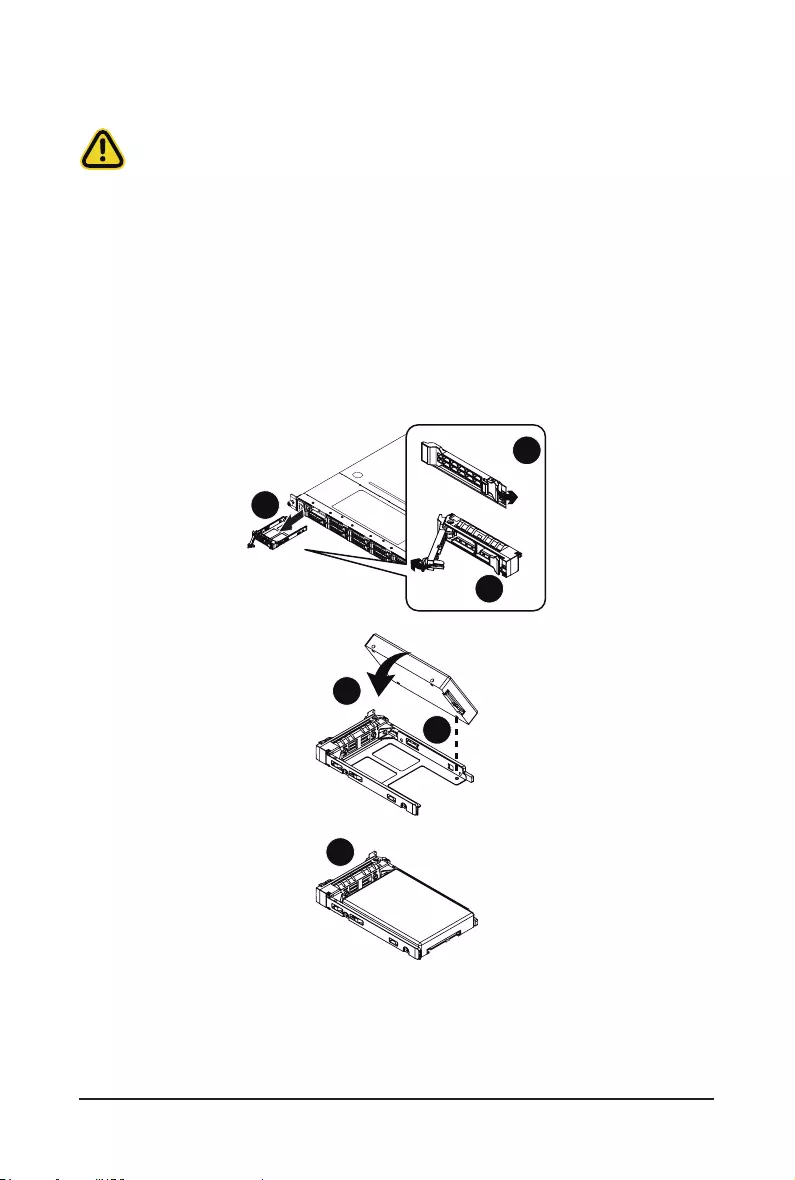
System Hardware Installation - 34 -
3-6 Installing the Hard Disk Drive
Read the following guidelines before you begin to install the Hard disk drive:
• Take note of the drive tray orientation before sliding it out.
• The tray will not t back into the bay if inserted incorrectly.
• Make sure that the HDD is connected to the HDD connector on the backplane.
Follow these instructions to install a 2.5" hard disk drive:
1. Press the release button.
2. Extend the locking lever.
3. Pull the locking lever in the direction indicated to remove the 2.5" HDD tray.
4. Orient the hard disk drive so the opening on the rear of the hard disk drive is aligned to the
positioning stud on the HDD tray.
5. Slide the hard disk drive into the HDD tray.
6. Reinsert the HDD tray into the slot and close the locking lever.
Press
Pull
1
2
3
5
4
6
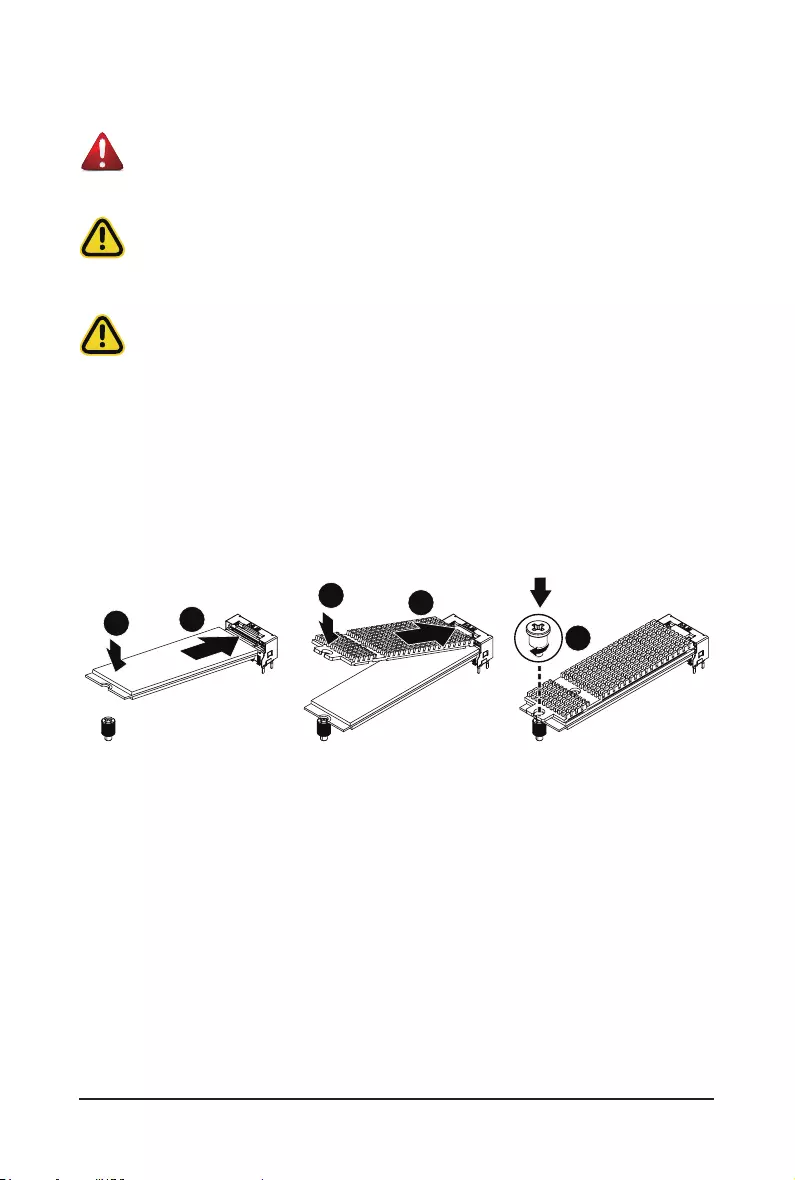
- 35 - System Hardware Installation
3-7 Installing the M.2 Device and Heat Sink
WARNING:
Installation of the thermal pad over the M.2 device is required when installing an M.2 device. Lack
of the thermal pad may result in system overheat and throttle the system performance.
CAUTION
The position of the stand-off screw will depend on the size of the M.2 device. The stand-off screw
is pre-installed for 22110 cards as standard. Refer to the size of the M.2 device and change the
position of the stand-off screw accordingly.
CAUTION
CPU TDP is limited to 155W if using M.2 device.
Follow these instructions to install the M.2 device and heat sink:
1. Insert the M.2 device into the M.2 connector.
2. Press down on the M.2 device.
3. Install the thermal pad of the M.2 device to the M.2 device.
4. Press down on the thermal pad.
5. Secure the M.2 device and its thermal pad to the motherboard with a single screw.
6. Reverse steps 1-4 to remove the M.2 device.
1
4
2
3
5

System Hardware Installation - 36 -
3-8 Replacing the Fan Assembly
Follow these instructions to replace the fan assembly:
1. Lift up the fan assembly from the chassis.
2. Reverse the previous steps to install the replacement fan assembly.

- 37 - System Hardware Installation
3-9 Replacing the Power Supply
Follow these instructions to replace the power supply:
1. Press the retaining clip on the right side of the power supply along the direction of the arrow.
2. Pull up the power supply handle at the same time and pull out the power supply.
3. Insert the replacement power supply rmly into the chassis. Connect the AC power cord to the
replacement power supply.
1
2
3

System Hardware Installation - 38 -
3-10 Cable Routing
3-10-1 Cable Routing for R162-Z10
System Main Power
Onboard SATA

- 39 - System Hardware Installation
HDD Backplane Board Signal
HDD Backplane Board Power

System Hardware Installation - 40 -
Front Panel IO
Front Panel USB
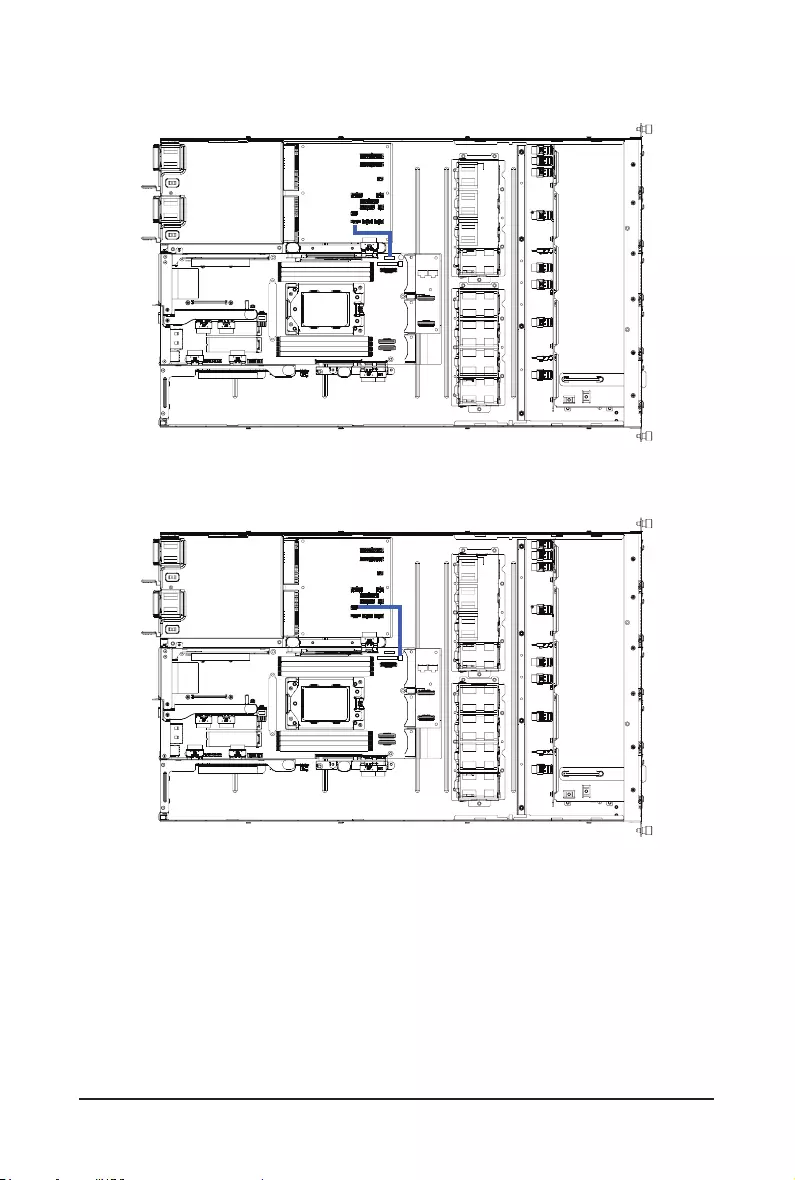
- 41 - System Hardware Installation
PMBus
PS-ON Signal

System Hardware Installation - 42 -
NVME
U2_0_1
U2_0
U2_1
U2_3
U2_3
U2_2
U2_4
U2_5
U2_4
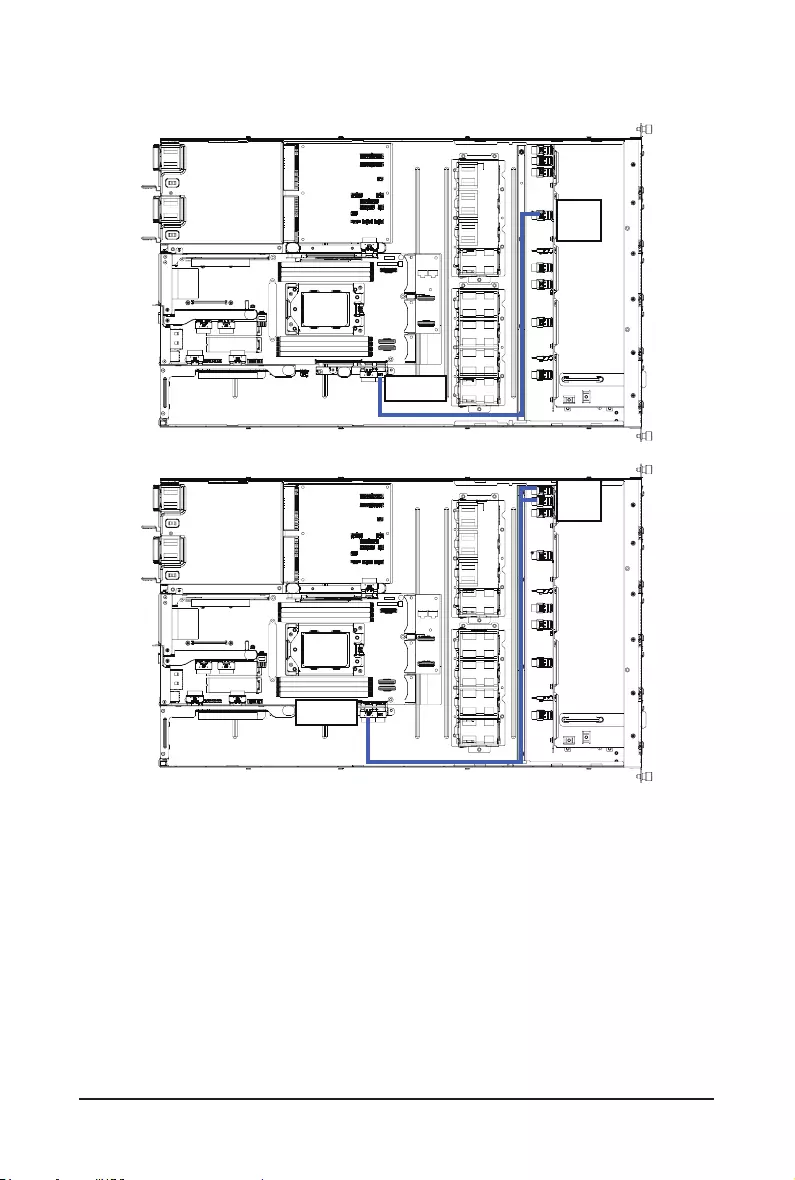
- 43 - System Hardware Installation
NVME
U2_2_3
U2_6
U2_7
U2_8
U2_9
U2_2_3
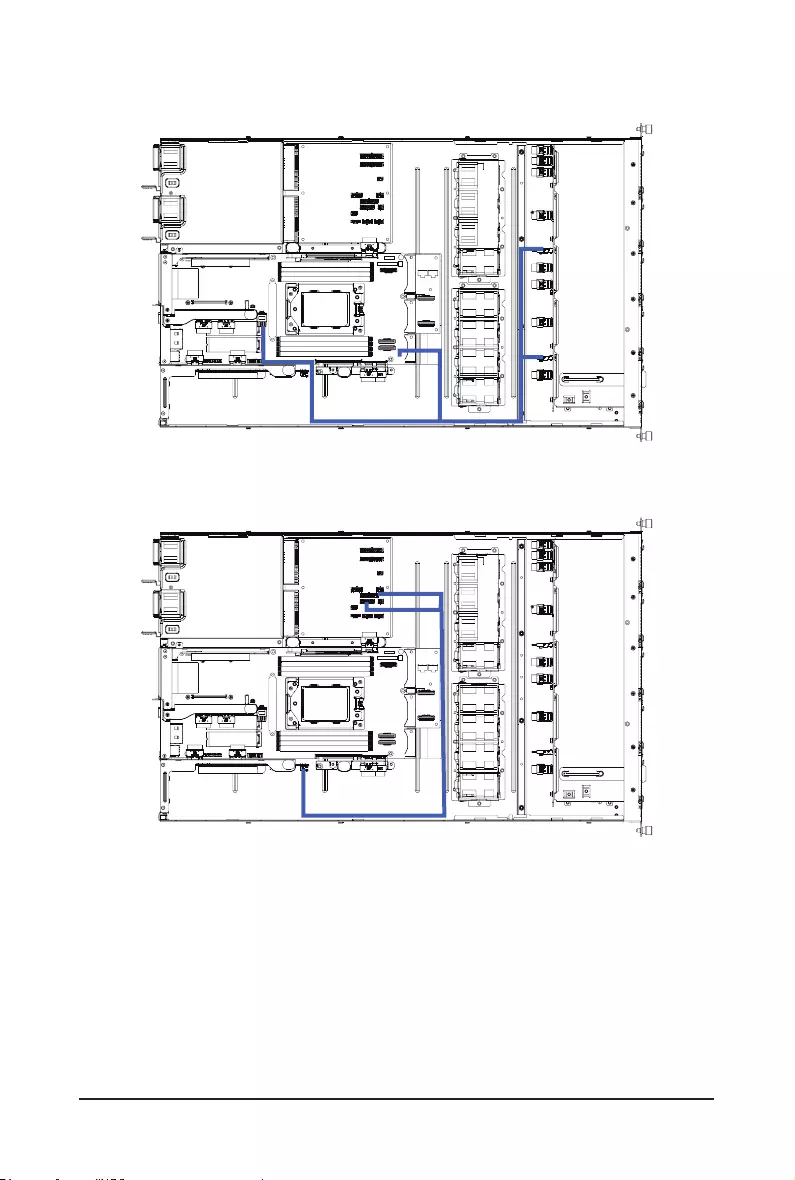
System Hardware Installation - 44 -
Onboard SATA
Riser Card Power

- 45 - System Hardware Installation
Riser Card SlimLine 8i #1
Riser Card SlimLine 8i #2

System Hardware Installation - 46 -
3-10-2 Cable Routing for R162-Z11
System Main Power
Onboard SATA

- 47 - System Hardware Installation
HDD Backplane Board Signal
HDD Backplane Board Power

System Hardware Installation - 48 -
Front Panel IO
Front Panel USB

- 49 - System Hardware Installation
PMBus
PS-ON Signal

System Hardware Installation - 50 -
NVME
U2_2_3
U2_6
U2_7
U2_8
U2_9
U2_2_3

- 51 - System Hardware Installation
Onboard SATA
Riser Card Power

System Hardware Installation - 52 -
Riser Card SlimLine 8i #1
Riser Card SlimLine 8i #2

- 53 - Motherboard Components
Chapter 4 Motherboard Components
4-1 Motherboard Components
Item Description
1 USB 3.0 Port x 2
2 ID LED
3IPMB Connector
4VGA Port
5Serial Port Cable Connector
6 GbE LAN Port x 2
7Server Management LAN Port
8Front Panel Connector
9 M.2 Connector (PCIe3 x4, Supports NGFF-22110)
10 Front USB 3.0 Connector
11 Proprietary PCIe x16 Slot (Gen3 x16)
12 SlimLine SAS Connector (U2_2B/PCIe)
13 SlimLine SAS Connector (U2_2A/PCIe)
14 Power & PCIe/SATA Connector
15 TPM Module Connector (SPI Interface)
16 Power & PCIe/SATA Connector
17 SGPIO Connector (SGPIO2)
18 Power & PCIe/SATA Connector
19 Power Connector
20 2 x 12 Pin Power Connector
21 PMBUs Connector
22 Proprietary PCIe x16 Slot (Gen3 x16)
23 Riser Slot #1
24 OCP Mezzanine Connector (OCP 2.0/Gen3 x16)
25 Riser Slot #2
26 HDD Back Plane Board Connector
27 System Battery Power Cable Connector
21
DIMM_P0_E0
DIMM_P0_F0
DIMM_P0_G0
DIMM_P0_H0
DIMM_P0_D0
DIMM_P0_C0
DIMM_P0_B0
DIMM_P0_A0
CPU
8
1
3
2
5
6
7
9
10
15
18
19
20
21
2223
24
23
25
27
26
24
4
11
14
16
13
12
17

Motherboard Components - 54 -
4-2 Jumper Setting
21
DIMM_P0_E0
DIMM_P0_F0
DIMM_P0_G0
DIMM_P0_H0
DIMM_P0_D0
DIMM_P0_C0
DIMM_P0_B0
DIMM_P0_A0
CPU
8
1
3
2
5
6
7
9
10
15
18
19
20
21
2223
24
23
25
27
26
24
4
11
14
16
13
12
17
Clear CMOS
CLR_CMOS
Default Enable
321
NCSI Switch
21
Onboard LAN
OCP Mezzanine
ON
OFF
-
21',3

- 55 - BIOS Setup
BIOS (Basic Input and Output System) records hardware parameters of the system in the EFI on the
motherboard. Its major functions include conducting the Power-On Self-Test (POST) during system startup,
saving system parameters and loading operating system, etc. BIOS includes a BIOS Setup program that
allows the user to modify basic system conguration settings or to activate certain system features. When the
power is turned off, the battery on the motherboard supplies the necessary power to the CMOS to keep the
conguration values in the CMOS.
To access the BIOS Setup program, press the <DEL> key during the POST when the power is turned on.
Chapter 1 BIOS Setup
• BIOS ashing is potentially risky, if you do not encounter problems of using the current BIOS
version, it is recommended that you don't ash the BIOS. To ash the BIOS, do it with caution.
Inadequate BIOS ashing may result in system malfunction.
• It is recommended that you not alter the default settings (unless you need to) to prevent system
instability or other unexpected results. Inadequately altering the settings may result in system's
failure to boot. If this occurs, try to clear the CMOS values and reset the board to default values.
(Refer to the Exit section in this chapter or introductions of the battery/clearing CMOS jumper in
Chapter 1 for how to clear the CMOS values.)
BIOS Setup Program Function Keys
<f><g> Move the selection bar to select the screen
<h><i> Move the selection bar to select an item
<+> Increase the numeric value or make changes
<-> Decrease the numeric value or make changes
<Enter> Execute command or enter the submenu
<Esc> Main Menu: Exit the BIOS Setup program
Submenus: Exit current submenu
<F1> Show descriptions of general help
<F3> Restore the previous BIOS settings for the current submenus
<F9> Load the Optimized BIOS default settings for the current submenus
<F10> Save all the changes and exit the BIOS Setup program

BIOS Setup - 56 -
Main
This setup page includes all the items in standard compatible BIOS.
Advanced
This setup page includes all the items of AMI BIOS special enhanced features.
(ex: Auto detect fan and temperature status, automatically congure hard disk parameters.)
AMD CBS
This setup page includes the common items for conguration of AMD motherboard-related information.
AMD PBS Option
This setup page includes the common items for conguration of AMD CPM RAS related settings.
Chipset
This setup page includes all the submenu options for conguring the function of processor, network,
North Bridge, South Bridge, and System event logs.
Server Management
Server additional features enabled/disabled setup menus.
Security
Change, set, or disable supervisor and user password. Conguration supervisor password allows you to
restrict access to the system and BIOS Setup.
A supervisor password allows you to make changes in BIOS Setup.
A user password only allows you to view the BIOS settings but not to make changes.
Boot
This setup page provides items for conguration of boot sequence.
Save & Exit
Save all the changes made in the BIOS Setup program to the CMOS and exit BIOS Setup. (Pressing
<F10> can also carry out this task.)
Abandon all changes and the previous settings remain in effect. Pressing <Y> to the confirmation
message will exit BIOS Setup. (Pressing <Esc> can also carry out this task.)

- 57 - BIOS Setup
5-1 The Main Menu
Once you enter the BIOS Setup program, the Main Menu (as shown below) appears on the screen. Use
arrow keys to move among the items and press <Enter> to accept or enter other sub-menu.
Main Menu Help
The on-screen description of a highlighted setup option is displayed on the bottom line of the Main Menu.
Submenu Help
While in a submenu, press <F1> to display a help screen (General Help) of function keys available for the
menu. Press <Esc> to exit the help screen. Help for each item is in the Item Help block on the right side of
the submenu.
• When the system is not stable as usual, select the Restore Defaults item to set your system
to its defaults.
• The BIOS Setup menus described in this chapter are for reference only and may differ by
BIOS version.
Parameter Description
BIOS Information
Project Name Displays the project name information.
Project Version Displays version number of the BIOS setup utility.
Build Date and Time Displays the date and time when the BIOS setup utility was created.
BMC Information
BMC Firmware Version Displays version number of the BIOS setup utility.

BIOS Setup - 58 -
Parameter Description
Onboard LAN Information
LAN1 MAC Address(Note1) Displays LAN MAC address information.
LAN2 MAC Address (Note1) Displays LAN MAC address information.
VR Information
Version Displays VR version information.
AGESA PI Version
PI Version Displays AGESA PI version information.
Memory Information
Total Memory(Note2) Displays the total memory size of the installed memory.
Memory Frequency(Note2) Displays the frequency information of the installed memory.
System Date Sets the date following the weekday-month-day-year format.
System Time Sets the system time following the hour-minute-second format.
(Note1) The number of LAN ports listed will depend on the motherboard / system model.
(Note2) This section will display capacity and frequency information of the memory that the customer
has installed.

- 59 - BIOS Setup
5-2 Advanced Menu
The Advanced menu display submenu options for conguring the function of various hardware components.
Select a submenu item, then press [Enter] to access the related submenu screen.

BIOS Setup - 60 -
Parameter Description
Conguration
Security Device Support Select Enabled to activate TPM support feature.
Options available: Enabled/Disabled. Default setting is Disabled.
SPI TPM Support Options available: Enabled/Disabled. Default setting is Enabled
Disable Block Sid Options available: Enabled/Disabled. Default setting is Disabled.
5-2-1 Trusted Computing
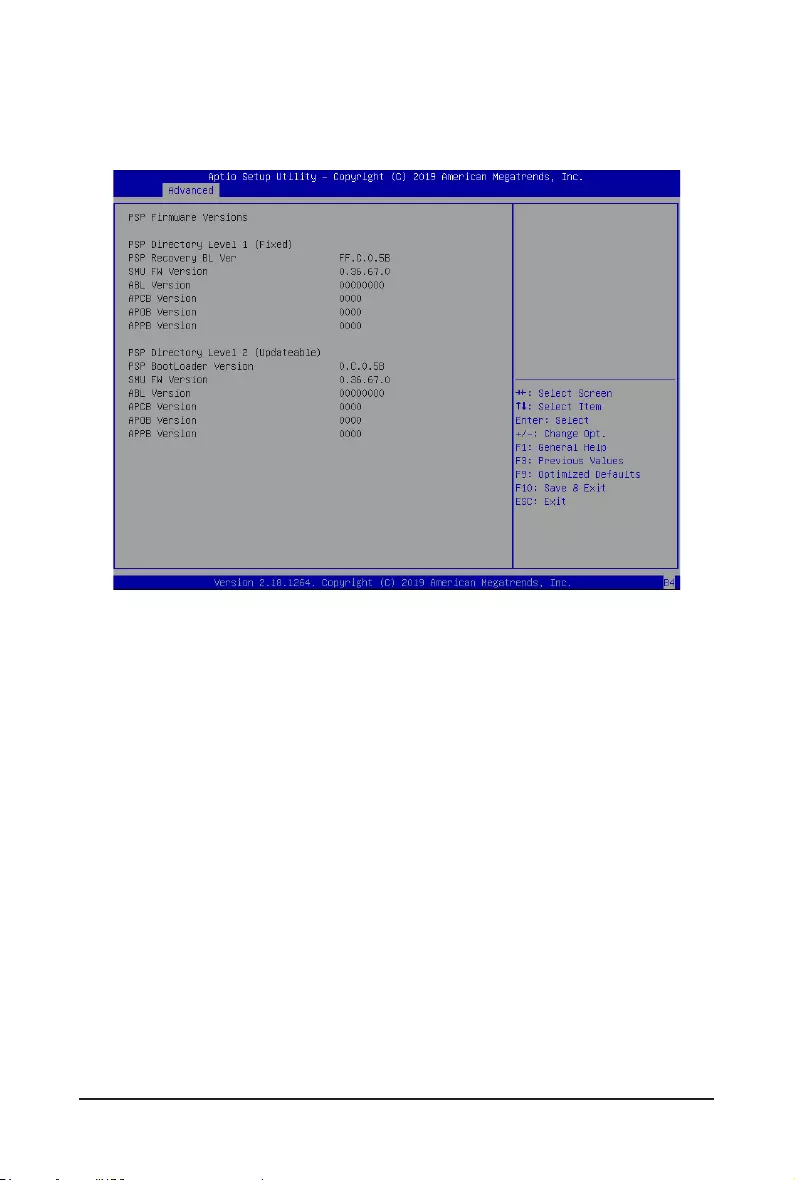
- 61 - BIOS Setup
5-2-2 PSP Firmware Versions
The PSP Firmware Versions page displays the basic PSP rmware version information. Items on this window
are non-congurable.

BIOS Setup - 62 -
5-2-3 Legacy Video Select
Parameter Description
OnBrd/Ext VGA Select Select between onboard or external VGA support.
Options available: Auto/Onboard/External. Default setting is Onboard.

- 63 - BIOS Setup
5-2-4 AST2500 Super IO Conguration
Parameter Description
AST2500 Super IO
Conguration
Super IO Chip
Serial Port 1/2
Conguration Press [Enter] for conguration of advanced items.

BIOS Setup - 64 -
5-2-4-1 Serial Port 1/2 Conguration

- 65 - BIOS Setup
Parameter Description
Serial Port 1/2
Conguration
Serial Port(Note1)
Enable/Disable the Serial Port (COM). When set to Enabled allows you to
congure the Serial port 1/2 settings. When set to Disabled, displays no
conguration for the serial port.
Options available: Enabled/Disabled. Default setting is Enabled.
Devices Settings(Note2) Displays the Serial Port 1/2 device settings.
Change Settings(Note2)
Select an optimal settings for Super IO Device.
Options available for Serial Port 1:
Auto
IO=3F8h; IRQ=4;
IO=3F8h; IRQ=3, 4, 5, 6, 7, 9, 10, 11, 12;
IO=2F8h; IRQ=3, 4, 5, 6, 7, 9, 10, 11, 12;
IO=3E8h; IRQ=3, 4, 5, 6, 7, 9, 10, 11, 12;
IO=2E8h; IRQ=3, 4, 5, 6, 7, 9, 10, 11, 12;
Default setting is Auto.
Options available for Serial Port 2:
Auto
IO=2F8h; IRQ=3;
IO=3F8h; IRQ=3, 4, 5, 6, 7, 9, 10, 11, 12;
IO=2F8h; IRQ=3, 4, 5, 6, 7, 9, 10, 11, 12;
IO=3E8h; IRQ=3, 4, 5, 6, 7, 9, 10, 11, 12;
IO=2E8h; IRQ=3, 4, 5, 6, 7, 9, 10, 11, 12;
Default setting is Auto.
Please note that this item is congurable when Serial Port is set to
Enabled.
(Note1) Advanced items prompt when this item is dened. (Note)
(Note2) This item appears when Serial Port is set to Enabled.

BIOS Setup - 66 -
5-2-5 S5 RTC Wake Settings
Parameter Description
Wake system from S5(Note)
Enable or disable System wake on alarm event. When enabled, System
will wake on the hr:min:sec specied.
Default setting is Disabled.
Wake up year Press <+> and <-> to dene the wake up year.
Wake up month Press <+> and <-> to dene the wake up month.
Wake up Date Press <+> and <-> to dene the wake up date.
Wake up hour Press <+> and <-> to dene the wake up hour.
Wake up minute Press <+> and <-> to dene the wake up minute.
Wake up second Press <+> and <-> to dene the wake up second.
(Note) This item appears when Wake system from S5 is set to Enabled.
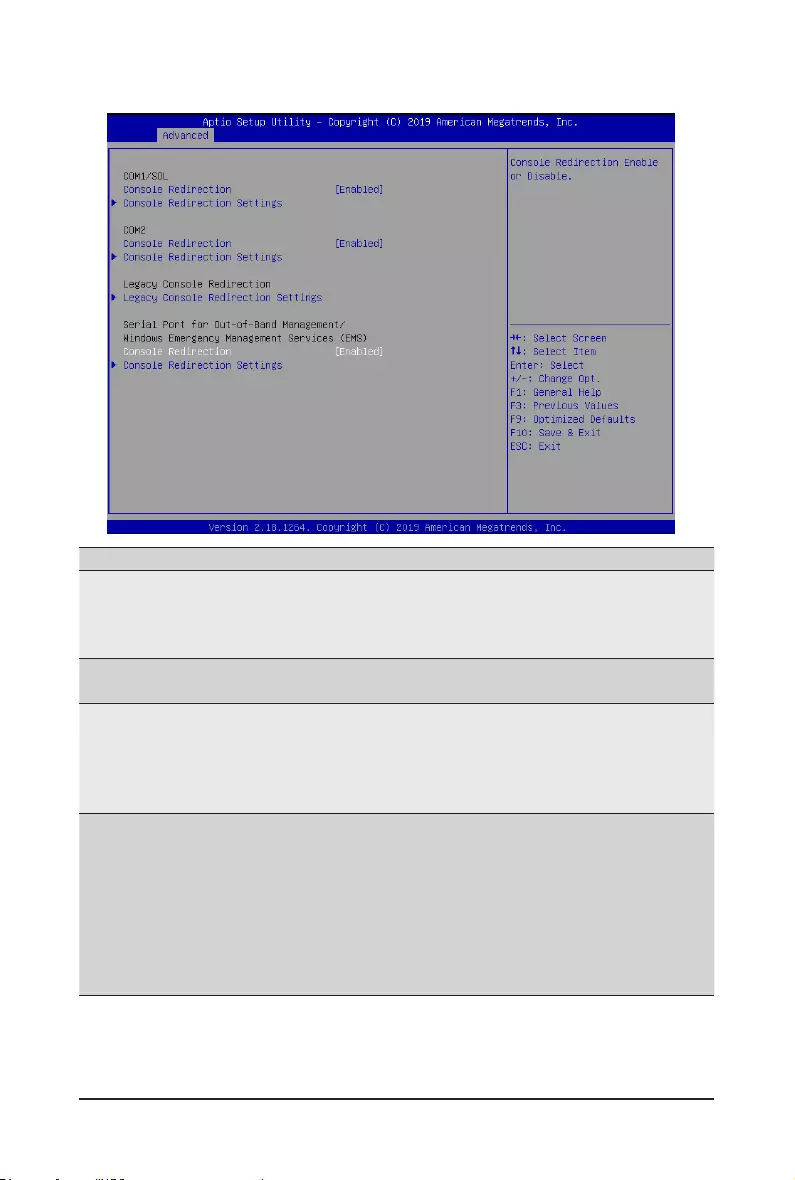
- 67 - BIOS Setup
5-2-6 Serial Port Console Redirection
(Note) Advanced items prompt when this item is dened.
Parameter Description
COM1/COM2 Serial Over
LAN Console Redirection(Note)
Select whether to enable console redirection for specied device. Console
redirection enables the users to manage the system from a remote
location.
Options available: Enabled/Disabled. Default setting is Disabled.
Legacy Console Redirection Selects a COM port for Legacy serial redirection. The options are
dependent on the available COM ports.
Serial Port for Out-of-Band
Management / Windows
Emergency Management
Services (EMS) Console
Redirection(Note)
Selects a COM port for EMS console redirection. EMS console redirection
allows the user to congure Console Redirection Settings to support Out-
of-Band Serial Port management.
Options available: Enabled/Disabled. Default setting is Disabled.
COM1/COM2 Serial LAN/
Legacy/Serial Port for Out-
of-Band EMS Console
Redirection Settings
Press [Enter] to congure advanced items.
Please note that this item is congurable when COM1 Serial Over
LAN/Serial Port for Out-of-Band Management EMS Console Redirec-
tion is set to Enabled.
Terminal Type
– Selects a terminal type to be used for console redirection.
– Options available: VT100/VT100+/ANSI /VT-UTF8. Default setting
is ANSI.

BIOS Setup - 68 -
Parameter Description
COM1/COM2 Serial LAN/
Legacy/Serial Port for Out-
of-Band EMS Console
Redirection Settings
(continued)
Bits per second
– Selects the transfer rate for console redirection.
– Options available: 9600/19200/38400/57600/115200. Default
setting is 115200.
Data Bits
– Selects the number of data bits used for console redirection.
– Options available: 7/8. Default setting is 8.
Parity
– A parity bit can be sent with the data bits to detect some
transmission errors.
– Even: parity bit is 0 if the num of 1's in the data bits is even.
– Odd: parity bit is 0 if num of 1's in the data bits is odd.
– Mark: parity bit is always 1. Space: Parity bit is always 0.
– Mark and Space Parity do not allow for error detection.
– Options available: None/Even/Odd/Mark/Space. Default setting is
None.
Stop Bits
– Stop bits indicate the end of a serial data packet. (A start bit
indicates the beginning). The standard setting is 1 stop bit.
Communication with slow devices may require more than 1 stop
bit.
– Options available: 1/2. Default setting is 1.
Flow Control
– Flow control can prevent data loss from buffer overow. When
sending data, if the receiving buffers are full, a 'stop' signal can
be sent to stop the data ow. Once the buffers are empty, a 'start'
signal can be sent to re-start the ow. Hardware ow control uses
two wires to send start/stop signals.
– Options available: None/Hardware RTS/CTS. Default setting is
None.
VT-UTF8 Combo Key Support
– Enable/Disable the VT-UTF8 Combo Key Support.
– Options available: Enabled/Disabled. Default setting is Enabled.
Recorder Mode(Note)
– When this mode enabled, only texts will be send. This is to capture
Terminal data.
– Options available: Enabled/Disabled. Default setting is Disabled.
Resolution 100x31(Note)
– Enable/Disable extended terminal resolution.
– Options available: Enabled/Disabled. Default setting is Enabled.
(Note) Advanced items prompt when this item is dened.
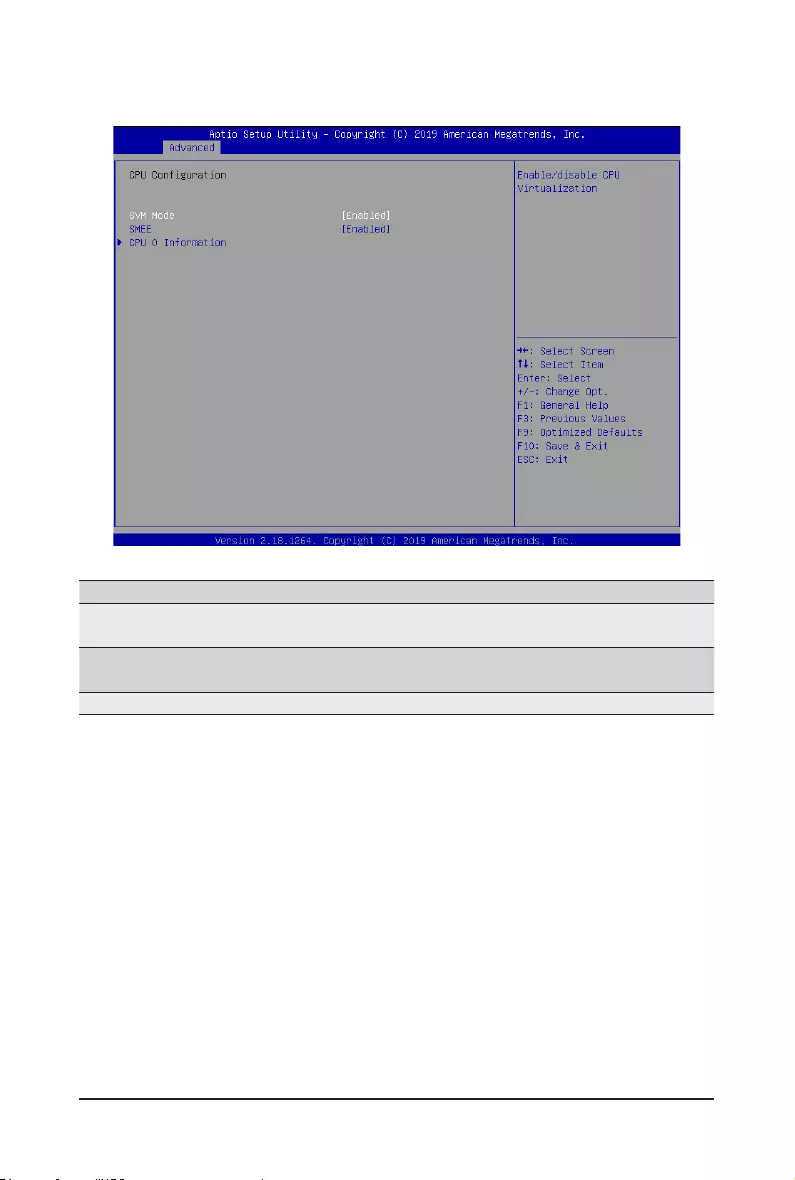
- 69 - BIOS Setup
5-2-7 CPU Conguration
Parameter Description
SVM Mode Enable/disable the CPU Virtualization.
Options available: Enabled/Disabled. Default setting is Enabled.
SMEE Controls the Secure Memory Encryption Enable (SMEE) function.
Options available: Enabled/Disabled. Default setting is Enabled.
CPU 0 Information Press [Enter] to view the memory information related to CPU 0.

BIOS Setup - 70 -
5-2-7-1 CPU 0 Information

- 71 - BIOS Setup
5-2-8 PCI Subsystem
Parameter Description
PCI Bus Driver Version Displays the PCI Bus Driver version information.
PCIE_#(Note1)
Change the PCIe lanes.
Options available: Auto/x16/x8x8/x8x4x4/x4x4x8/x4x4x4x4/
Disabled. Default setting is Auto.
PCI Express Slot # I/O ROM (Note1)
When enabled, this setting will initialize the device expansion
ROM for the related PCI-E slot.
Options available: Enabled/Disabled. Default setting is Enabled.
MEZZ
Change mezzanine PCIe lanes.
Options available: Auto/x16/x8x8/x8x4x4/x4x4x8/x4x4x4x4/
Disabled. Default setting is Auto.
MEZZ I/O ROM
When enabled, this setting will initialize the device expansion
ROM for the related U.2 device.
Options available: Enabled/Disabled. Default setting is Enabled.
Onboard LAN1 / LAN2 Controller(Note2) Enable/Disable the onboard LAN1 / LAN2 devices.
Options available: Enabled/Disabled. Default setting is Enabled.
Onboard LAN1 / LAN2 I/O ROM(Note2)
Enable/Disable the onboard LAN1 / LAN2 devices, and initializes
device expansion ROM.
Options available: Enabled/Disabled. Default setting is Enabled.
(Note1) This section is dependent on the available PCIe Slot.
(Note2) This section is dependent on the available LAN controller.

BIOS Setup - 72 -
Parameter Description
PCI Devices Common Settings
Above 4G Decoding
Enable/Disable memory mapped I/O to 4GB or greater address
space (Above 4G Decoding).
Options available: Enabled/Disabled. Default setting is Enabled.
SR-IOV Support
If the system has SR-IOV capable PCIe devices, this item
Enable/Disable Single Root IO Virtualization Support.
Options available: Enabled/Disabled. Default setting is Enabled.
PCI-E AER Enabled Options available: Enabled/Disabled. Default setting is Disabled

- 73 - BIOS Setup
5-2-9 USB Conguration
Parameter Description
USB Conguration
USB Controller Displays the supported USB controllers.
USB Devices: Displays the USB devices connected to the system.
Legacy USB Support
Enable/disable the Legacy USB support fuction. AUTO option disables
legacy support if no USB devices are connected. DISABLE option will
keep USB devices available only for EFI applications.
Options available: Auto/Enabled/Disabled. Default setting is Enabled.
XHCI Hand-off Enable/Disable the XHCI (USB 3.0) Hand-off support.
Options available: Enabled/Disabled. Default setting is Enabled.
USB Mass Storage Driver
Support(Note)
Enable/Disable the USB Mass Storage Driver Support.
Options available: Enabled/Disabled. Default setting is Enabled.
Port 60/64 Emulation
Enables the I/O port 60h/64h emulation support. This should be enabled
for the complete USB Keyboard Legacy support for non-USB aware OS.
Options available: Enabled/Disabled. Default setting is Enabled.
USB hardware delays and
time-outs
USB transfer time out The time-out value for Control, Bulk, and Interrupt transfers.
Options available: 1 sec/5 sec/10 sec/20 sec. Default setting is 20 sec.
Device reset time out USB mass storage device Start Unit command time-out.
Options available: 10 sec/20 sec/30 sec/40 sec. Default setting is 20 sec.
(Note) This item is present only if you attach USB devices.

BIOS Setup - 74 -
Device power-up delay
Maximum time the device will take before it properly reports itself to the
Host Controller. "Auto" uses default value: for a Root port it is 100
ms, for a Hub port the delay is taken from Hub descriptor.
Options available: Auto/Manual. Default setting is Auto.
Mass Storage Devices Displays the mass storage devices avaiable on the system.

- 75 - BIOS Setup
5-2-10 NVMe Conguration
Parameter Description
NVMe controller and Drive
Information Displays the NVMe devices connected to the system.

BIOS Setup - 76 -
5-2-11 SATA Conguration

- 77 - BIOS Setup
5-2-12 Network Stack
(Note) This item appears when Network Stack is set to Enabled.
Parameter Description
Network Stack Enable/Disable the UEFI network stack.
Options available: Enabled/Disabled. Default setting is Enabled.
Ipv4 PXE Support(Note) Enable/Disable the Ipv4 PXE feature.
Options available: Enabled/Disabled. Default setting is Enabled.
Ipv4 HTTP Support(Note) Enable/Disable the Ipv4 HTTP feature.
Options available: Enabled/Disabled. Default setting is Disabled.
Ipv6 PXE Support(Note) Enable/Disable the Ipv6 PXE feature.
Options available: Enabled/Disabled. Default setting is Disabled.
Ipv6 HTTP Support(Note) Enable/Disable the Ipv6 HTTP feature.
Options available: Enabled/Disabled. Default setting is Disabled.
IPSEC Certicate(Note) Enable/Disable the IPSEC Certicate feature.
Media detect count(Note) Press the <+> / <-> keys to increase or decrease the desired values.

BIOS Setup - 78 -
5-2-13 AMD Mem Conguration Status
Parameter Description
CPU0 Press [Enter] for conguration of advanced items.

- 79 - BIOS Setup
5-2-14 iSCSI Conguration
Parameter Description
iSCSI Initiator Name
Add Attempt Press [Enter] for conguration of advanced items.
Delete Attempt Press [Enter] for conguration of advanced items.
Change Attempt Order Press [Enter] for conguration of advanced items.

BIOS Setup - 80 -
5-2-15 Tls Auth Conguration
Parameter Description
Save CA Conguration Press [Enter] for conguration of advanced items.
Client Cert Conguration Press [Enter] for conguration of advanced items.

- 81 - BIOS Setup
5-2-16 AVAGO MegaRAID Conguration Utility

BIOS Setup - 82 -
Parameter Description
Main Menu Press [Enter] for conguration of advanced items.
Help Press [Enter] for conguration of advanced items.
PROPERTIES
Status
Current Personality
Backplane
BBU
Enclosure
Drives
Drive Gropus
Virtual Drives
View Server Prole Press [Enter] for conguration to view Server Prole.
Action
Congure Press [Enter] for conguration of advanced items.
Set Factory Defaults Press [Enter] to active this function.
Update Firmware Press [Enter] to active this function.
Silience Alarm Press [Enter] to active this function.
BACKGROUND
OPERATIONS in Progress
MegaRAID ADVANCED
SOFTWARE OPTIONS
MegaRAID RAID6
MegaRAID RAID5
MegaRAID FastPath
Manage MegaRAID Advanced
Software Options Press [Enter] for conguration of advanced items.

- 83 - BIOS Setup
5-2-17 Intel(R) I350 Gigabit Network Connection

BIOS Setup - 84 -
Parameter Description
NIC Conguration
Press [Enter] to congure advanced items.
Link Speed
– Allows for automatic link speed adjustment.
– Options available: Auto Negotiated/10 Mbps Half/10 Mbps Full/100
Mbps Half/100 Mbps Full. Default setting is Auto Negotiated.
Wake On LAN
– Enables power on of the system via LAN. Note that conguring
Wake on LAN in the operating system does not change the value
of this setting, but does override the behavior of Wake on LAN in
OS controlled power states.
– Options available: Enabled/Disabled. Default setting is Enabled.
Blink LEDs Identies the physical network port by blinking the associated LED.
Press the numeric keys to adjust desired values.
UEFI Driver Displays the technical specications for the Network Interface Controller.
Adapter PBA Displays the technical specications for the Network Interface Controller.
Device Name Displays the technical specications for the Network Interface Controller.
Chip Type Displays the technical specications for the Network Interface Controller.
PCI Device ID Displays the technical specications for the Network Interface Controller.
PCI Address Displays the technical specications for the Network Interface Controller.
Link Status Displays the technical specications for the Network Interface Controller.
MAC Address Displays the technical specications for the Network Interface Controller.
Virtual MAC Address Displays the technical specications for the Network Interface Controller.
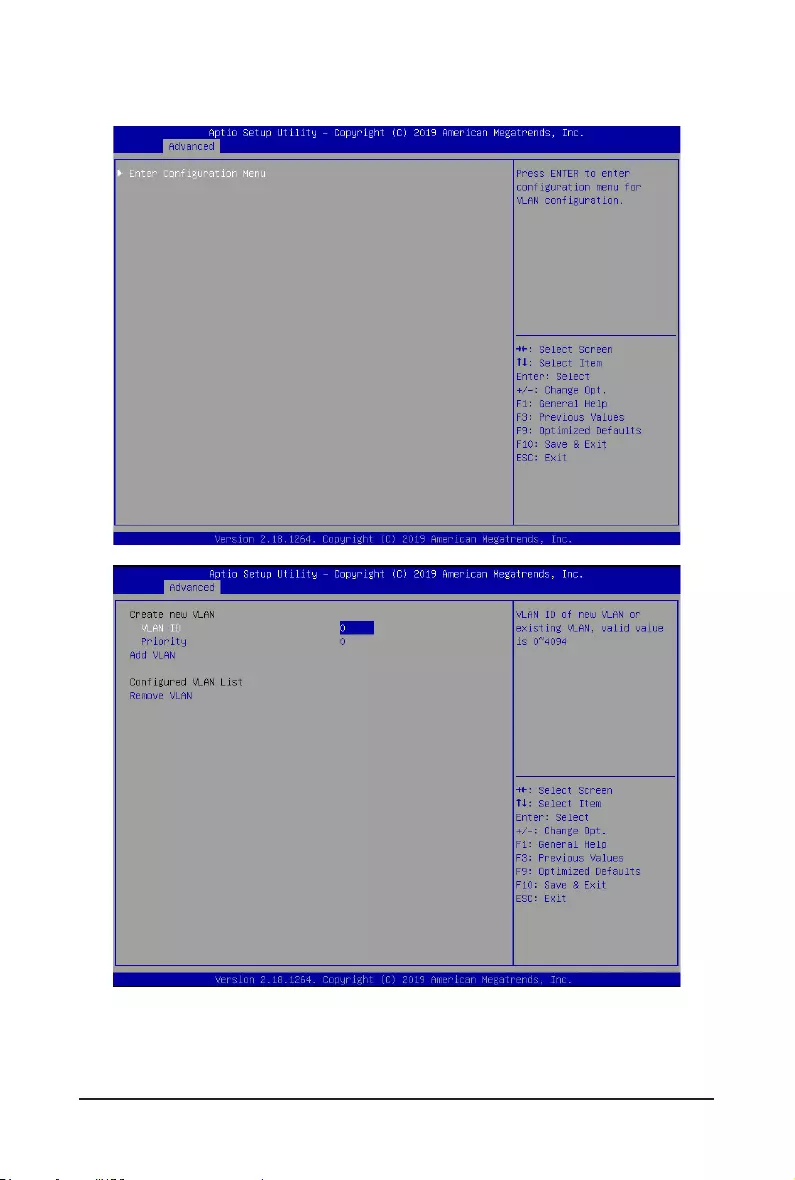
- 85 - BIOS Setup
5-2-18 VLAN Conguration

BIOS Setup - 86 -
Parameter Description
Enter Conguration Menu
Press [Enter] to congure advanced items.
Create new VLAN
VLAN ID
– Sets VLAN ID for a new VLAN or an existing VLAN.
– Press the <+> / <-> keys to increase or decrease the desired values.
– The valid range is from 0 to 4094.
Priority
– Sets 802.1Q Priority for a new VLAN or an existing VLAN.
– Press the <+> / <-> keys to increase or decrease the desired values.
– The valid range is from 0 to 7.
Add VLAN
– Press [Enter] to create a new VLAN or update an existing VLAN.
Congured VLAN List
– Enable/Disable the VLAN.
– Options available: Enable/Disable. Default setting is Disable.
Remove VLAN
– Press [Enter] to remove an existing VLAN.
(Note) Only Supported when Congured VLAN List is set to Enabled.

- 87 - BIOS Setup
5-2-19 MAC IPv4 Network Conguration
Parameter Description
Congured Options available: Enabled/Disabled. Default setting is Enabled.
Enable DHCP Options available: Enabled/Disabled. Default setting is Enabled.
Local IP Address Press [Enter] to congure local IP address.
Local NetMask Press [Enter] to congure local NetMask.
Local Gateway Press [Enter] to congure local Gateway
Local DNS Servers Press [Enter] to congure local DNS servers
Save Changes and Exit Press [Enter] save all congurations.

BIOS Setup - 88 -
5-2-20 MAC IPv6 Network Conguration
Parameter Description
Enter Conguration Menu Press [Enter] for conguration of advanced items.

- 89 - BIOS Setup
5-3 AMD CBS Menu
AMD CBS menu displays submenu options for configuring the CPU-related information that the BIOS
automatically sets. Select a submenu item, then press [Enter] to access the related submenu screen.

BIOS Setup - 90 -
5-3-1 Valhalla Common Options
Parameter Description
Performance Press [Enter] for conguration of advanced items.
Prefetcher settings Press [Enter] for conguration of advanced items.
Core Watchdog Press [Enter] for conguration of advanced items.
RedirectForReturnDis Options available: Auto/1/0. Default setting is Auto.
Platform First Error Warning Options available: Auto/Enabled/Disabled. Default setting is Auto.
Core Performance Boost Options available: Auto/Disabled. Default setting is Auto.
Global C-State Control Options available: Auto/Enabled/Disabled. Default setting is Auto.
Power Supply Idle Control Options available: Auto/Low Current Idle/Typical Current Idle. Default
setting is Auto.
Opcache Control Options available: Auto/Enabled/Disabled. Default setting is Auto.
SEV ASID Count Options available: Auto/253 ASIDs/509 ASIDs. Default setting is Auto.
SEV-ES ASID Space Limit
Control Options available: Auto/Manual. Default setting is Auto.
Streaming Stores Control Options available: Auto/Enabled/Disabled. Default setting is Auto.
ACPI_CST C1 Decaration Options available: Auto/Enabled/Disabled. Default setting is Auto.
Local APIC Mode Options available: Auto/xAPIC/x2APIC. Default setting is Auto.
MCA error thresh enable Options available: Auto/False/True. Default setting is Auto.

- 91 - BIOS Setup
Parameter Description
SMU and PSP Debug Mode Options available: Auto/Enabled/Disabled. Default setting is Auto.
Xtrig7 Workaround Options available: Auto/No Workaround/ Bronze Workaround/ Sliver
Workaround. Default setting is Auto.
PPIN Opt-in Options available: Auto/Enabled/Disabled. Default setting is Auto.

BIOS Setup - 92 -
5-3-2 DF Common Options
Parameter Description
Scrubber Press [Enter] for conguration of advanced items.
Memory Addressing Press [Enter] for conguration of advanced items.
ACPI Press [Enter] for conguration of advanced items.
Link Press [Enter] for conguration of advanced items.
Disable DF to external IP
sync ood propagation
Options available: Auto/Sync ood disabled/Sync ood enabled. Default
setting is Auto.
Disable DF sync ood
propagation
Options available: Auto/Sync ood disabled/Sync ood enabled. Default
setting is Auto.
Frezze DF module queues on
error Options available: Auto/Enabled/Disabled. Default setting is Auto.
CC6 memory region
encryption Options available: Auto/Enabled/Disabled. Default setting is Auto.
System probe lter Options available: Auto/Enabled/Disabled. Default setting is Auto.
Memory Clear Options available: Auto/Enabled/Disabled. Default setting is Auto.
PSP error injection support Options available: False/True. Default setting is False.
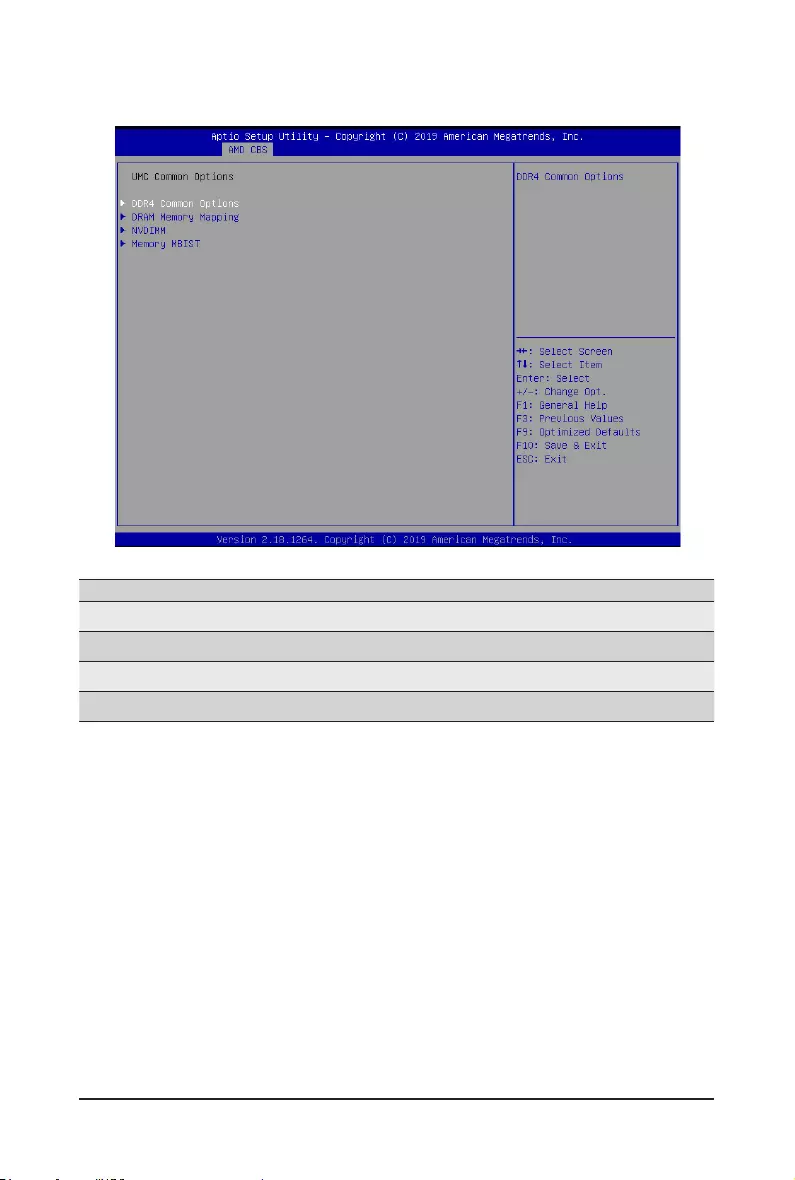
- 93 - BIOS Setup
5-3-3 UMC Common Options
Parameter Description
DDR4 Common Options Press [Enter] for conguration of advanced items.
DRAM Memory Mapping Press [Enter] for conguration of advanced items.
NVDIMM Press [Enter] for conguration of advanced items.
Memory MBIST Press [Enter] for conguration of advanced items.

BIOS Setup - 94 -
5-3-3-1 DDR4 Common Options
Parameter Description
Enforce POR Press [Enter] to congure the enforce POR.
DRAM Controller
Conguration Press [Enter] to congure the DRAM controller.
CAD Bus Conguration Press [Enter] to congure the cad bus.
Data Bus Conguration Press [Enter] to congure the data bus.
Common RAS Press [Enter] to congure the common RAS.
Security Press [Enter] to congure security.

- 95 - BIOS Setup
5-3-3-2 DRAM Memory Mapping
Parameter Description
Chipselect Interleaving Interleave memory blocks across the DRAM chip selects for CPU 0.
Options available: Disabled/Auto. Default setting is Auto.
BankGroupSwap
Congures the BankGroupSwap. BankGroupSwap (BGS) is a new
memory mapping option in AGESA that alters how applications get
assigned to physical locations within the memory modules. When this
option sets to Auto, it is null: No help string.
Options available: Enabled/Disabled/Auto. Default setting is Auto.
BankGroupSwapAlt Options available: Enabled/Disabled/Auto. Default setting is Auto.
Address Hash Bank Options available: Enabled/Disabled/Auto. Default setting is Auto.
Address Hash CS Options available: Enabled/Disabled/Auto. Default setting is Auto.
Address Hash Rm Options available: Enabled/Disabled/Auto. Default setting is Auto.
SPD Read Optimization Enable or disable SPD Read Optimization.
Options available: Enabled/Disabled/Auto. Default setting is Auto.

BIOS Setup - 96 -
5-3-3-3 NVDIMM

- 97 - BIOS Setup
5-3-3-4 Memory MBIST
Parameter Description
MBIST Enable Options available: Enabled/Disabled. Default setting is Disabled.
MBIST Test Mode(Note) Options available: Interface Mode/Data Eye Mode/Both/Auto. Default
setting is Auto.
MBIST Aggressors (Note) Options available: Auto/Enabled/Disabled. Default setting is Auto.
MBIST Per Bit Slave Die
Reporting(Note) Options available: Auto/Enabled/Disabled. Default setting is Auto.
Data Eye Press [Enter] for conguration of advanced items.
(Note) This item appears when MBIST Enable is set to Enabled.

BIOS Setup - 98 -
5-3-4 NBIO Common Options
Parameter Description
IOMMU Options available: Enabled/Disabled. Default setting is Disabled.
ACS Enable Options available: Auto/Enabled/Disabled. Default setting is Auto.
PCIe ARI Support Options available: Auto/Enabled/Disabled. Default setting is Auto.
PCIe Ten Bit Tag Support Options available: Auto/Enabled/Disabled. Default setting is Auto.
HD Audio Enable Press [Enter] for conguration of advanced items.
SMU Common Options Press [Enter] for conguration of advanced items.
NBIO RAS Common Options Press [Enter] for conguration of advanced items.
Enable AER Cap Options available: Auto/Enabled/Disabled. Default setting is Auto.
Early Link Speed Options available: Auto/Gen1/Gen2. Default setting is Auto.
Hot Plug Handling mode Options available: Auto/A0 Mode/OS First (No Error Handling)/OS First
(Error Handling-Not Implemented). Default setting is Auto.
Presence Detect Select mode Options available: Auto/OR/AND. Default setting is Auto.
Preferred IO Device

- 99 - BIOS Setup
5-3-5 FCH Common Options
Parameter Description
SATA Conguration Options Press [Enter] for conguration of advanced items.
USB Conguration Options Press [Enter] for conguration of advanced items.
SD Dump Options Press [Enter] for conguration of advanced items.
AC Power Loss Options Press [Enter] to congure the AC loss control.
I2C Conguration Options Press [Enter] for conguration of advanced items.
Uart Conguration Options Press [Enter] for conguration of advanced items.
ESPI Conguration Options Press [Enter] for conguration of advanced items.
eMMC Options Press [Enter] for conguration of advanced items.
FCH RAS Options Press [Enter] for conguration of advanced items.

BIOS Setup - 100 -
5-3-6 NTB Common Options
Parameter Description
NTB Options available: Auto/Enabled. Default setting is Auto.

- 101 - BIOS Setup
5-3-7 SOC Miscellaneous Control
Parameter Description
ABL Console Out Control Options available: Auto/Enabled/Disabled. Default setting is Auto.
ABL PMU message
Control(Note) Options available: Auto/Enabled/Disabled. Default setting is Auto.
(Note) This item appears when ABL Console Out Control is set to Enabled.

BIOS Setup - 102 -
5-4 AMD PBS Option Menu
AMD PBS Option menu displays submenu options for configuring the function of AMD PBS. Select a
submenu item, then press [Enter] to access the related submenu screen.
Parameter Description
RAS Press [Enter] for conguration of advanced items.
SPI Locking Options available: Enabled/Disabled. Default setting is Disabled.

- 103 - BIOS Setup
5-4-1 RAS
Parameter Description
RAS Periodic SMI Control Options available: Enabled/Disabled. Default setting is Disabled.
SMI Threshold Set the SMI Threshold value.
SMI Scale Set the SMI Scale value.
SMI Scale Unit Options available: millisecond/second/minute. Default setting is
millsecond.
SMI Period Set the SMI Period.
GHES Notify Type Options available: Polled/SCI. Default setting is Polled.
GHES UnCorr Notify Type Options available: Polled/NMI. Default setting is NMI.
PCIe GHES Notify Type Options available: Polled/SCI. Default setting is Polled.
PCIe UnCorr GHES Notify
Type Options available: Polled/NMI. Default setting is NMI.
PCIe Root Port Corr Err Mask
Reg Initialize the PCIe AER Corrected Error Mask register of Root Port.
PCIe Root Port UnCorr Err
Mask Reg Initialize the PCIe AER Uncorrected Error Mask register of Root Port.
PCIe Root Port UnCorr Err
Sev Reg Initialize the PCIe AER Uncorrected Error Serverity register of Root Port.

BIOS Setup - 104 -
Parameter Description
PCIe Device Corr Err Mask
Reg
Initialize the PCIe AER Corrected Error Mask register of PCIe
device.
PCIe Device UnCorr Err Mask
Reg
Initialize the PCIe AER Uncorrected Error Mask register of PCIe
device.
PCIe Device UnCorr Err Sev
Reg
Initialize the PCIe AER Uncorrected Error Serverity register of PCIe
device.
CCIX GHES Deferred ERR
Notify Type
Notication type for CCIX deffered error.
Options available: Polled/SCI. Default setting is Polled.
CCIX GHES Corrected Err
Notify Type
Notication type for CCIX corrected error.
Options available: Polled/SCI. Default setting is Polled.
DDR4 DRAM Hard Post
Package Repair
This feature allows spare DRAM rows to replace malfunctioning rows via
an in-eld repair mechanism.
Options available: Enabled/Disabled. Default setting is Disabled.
HEST DMC Structure Support HEST DMC (Deferred Machine Check) Structure Support.
Options available: Enabled/Disabled. Default setting is Disabled.

- 105 - BIOS Setup
5-5 Chipset Setup Menu
Chipset Setup menu displays submenu options for conguring the function of the North Bridge. Select a
submenu item, then press [Enter] to access the related submenu screen.
Parameter Description
PCIe Link Training Type PCIe Link training in 1 or 2 steps.
Options available: 1 Step/2Step. Default setting is 1 Step.
PCIe Compliance Mode Options available: On/Off. Default setting is Off.
Program All VR Enable/Disable program all VR on MB.
Options available: Enabled/Disabled. Default setting is Enabled.
North Bridge Press [Enter] for conguration of advanced items.

BIOS Setup - 106 -
5-5-1 North Bridge
Parameter Description
Memory Information
Total Memory Displays the total memory information.
CPU0 Information Press [Enter] to view information related to CPU 0.

- 107 - BIOS Setup
5-6 Server Management Menu
(Note) Advanced items prompt when OS Watchdog Timer is set to Enabled.
Parameter Description
FRB-2 Timer Enable/Disable FRB-2 timer (POST timer).
Options available: Enabled/Disabled. Default setting is Disabled.
FRB-2 Timer
timeout
Congure the FRB2 Timer timeout.
Options available: 3 minutes/4 minutes/5 minutes/6 minutes. Default setting is 6
minutes.
Please note that this item is congurable when FRB-2 Timer is set to Enabled.
FRB-2 Timer Policy
Congure the FRB2 Timer policy.
Options available: Do Nothing/Reset/Power Down. Default setting is Do Nothing.
Please note that this item is congurable when FRB-2 Timer is set to Enabled.
OS Watchdog
Timer
Enable/Disable OS Watchdog Timer function.
Options available: Enabled/Disabled. Default setting is Disabled.
OS Wtd Timer
Timeout(Note)
Congure OS Watchdog Timer.
Options available: 5 minutes/10 minutes/15 minutes/20 minutes. Default setting is 10
minutes.
Please note that this item is congurable when OS Watchdog Timer is set to
Enabled.
OS Wtd Timer
Policy(Note)
Congure OS Watchdog Timer Policy.
Options available: Reset/Do Nothing/Power Down. Default setting is Reset.
Please note that this item is congurable when OS Watchdog Timer is set to
Enabled.

BIOS Setup - 108 -
Parameter Description
System Event Log Press [Enter] to congure advanced items.
View FRU
Information Press [Enter] to view the advanced items.
BMC network
conguration Press [Enter] to congure advanced items.
IPv6 BMC Network
Conguration Press [Enter] to congure advanced items.

- 109 - BIOS Setup
5-6-1 System Event Log
Parameter Description
Enabling / Disabling Options
SEL Components
Change this item to enable or disable all features of System Event
Logging during boot.
Options available: Enabled/Disabled. Default setting is Enabled.
Erasing Settings
Erasing SEL
Choose options for erasing SEL.
Options available: No/Yes, On next reset/Yes, On every reset. Default
setting is No.
When SEL is Full
Choose options for reactions to a full SEL.
Options available: Do Nothing/Erase Immediately. Default setting is Do
Nothing.
Custom EFI Logging Options
Log EFI Status Codes
Enable/Disable the logging of EFI Status Codes (if not already converted
to legacy).
Options available: Disabled/Both/Error code/Progress code. Default
setting is Error code.

BIOS Setup - 110 -
5-6-2 View FRU Information
The FRU page is a simple display page for basic system ID information, as well as System product
information. Items on this window are non-congurable.
(Note) The model name will vary depends on the product you purchased.

- 111 - BIOS Setup
5-6-3 BMC Network Conguration
Parameter Description
BMC network conguration
Lan Channel 1
Conguration Address source
Select to congure LAN channel parameters statically or dynamically
(DHCP). Do nothing option will not modify any BMC network parameters
during BIOS phase.
Options available: Unspecied/Static/DynamicBmcDhcp. Default setting
is DynamicBmcDhcp.
Station IP address Displays IP Address information.
Subnet mask
Displays Subnet Mask information.
Please note that the IP address must be in three digitals, for example,
192.168.000.001.
Router IP address Displays the Router IP Address information.
Station MAC address Displays the MAC Address information.
Real-time synchronize BMC
network parameter values Press [Enter] to synchronize the BMC network parameter values.

BIOS Setup - 112 -
5-6-4 IPv6 BMC Network Conguration
Parameter Description
IPv6 BMC Network
Conguration
IPv6 BMC Lan Channel 1
IPv6 BMC Lan Option
Enable/Disable IPv6 BMC LAN channel function. When this item is
disabled, the system will not modify any BMC network during BIOS
phase.
Options available: Enable/Disable. Default setting is Enable.
IPv6 BMC Lan IP Address
Source
Select to congure LAN channel parameters statically or dynamically (by
BIOS or BMC).
Options available: Unspecied/Static/Dynamic-Obtained by BMC running
DHCP.
Default setting is Dynamic-Obtained by BMC running DHCP.
IPv6 BMC Lan IP Address/
Prex Length
Check if the IPv6 BMC LAN IP address matches those displayed on the
screen.

- 113 - BIOS Setup
5-7 Security Menu
The Security menu allows you to safeguard and protect the system from unauthorized use by setting up
access passwords.
There are two types of passwords that you can set:
• Administrator Password
Entering this password will allow the user to access and change all settings in the Setup Utility.
• User Password
Entering this password will restrict a user’s access to the Setup menus. To enable or disable
this eld, a Administrator Password must rst be set. A user can only access and modify the
System Time, System Date, and Set User Password elds.
Parameter Description
Administrator Password Press [Enter] to congure the administrator password.
User Password Press [Enter] to congure the user password.
Secure Boot Press [Enter] to congure advanced items.

BIOS Setup - 114 -
5-7-1 Secure Boot
Parameter Description
System Mode Displays the system is in User mode or Setup mode.
Secure Boot Mode(Note)
Secure Boot requires all the applications that are running during the
booting process to be pre-signed with valid digital certicates. This way,
the system knows all the les being loaded before Windows loads and
gets to the login screen have not been tampered with.
When set to Standard, it will automatically load the Secure Boot keys
form the BIOS databases.
When set to Custom, you can customize the Secure Boot settings and
manually load its keys from the BIOS database.
Options available: Standard/Custom. Default setting is Custom.
(Note) Advanced items prompt when this item is set to Custom.

- 115 - BIOS Setup
Parameter Description
Key Management
Press [Enter] to congure advanced items.
Please note that this item is congurable when Secure Boot Mode is set
to Custom.
Provision Factory Defaults
– Allows to provision factory default Secure Boot keys when system is in
Setup Mode.
– Options available: Enabled/Disabled. Default setting is Disabled.
Install Factory Default Keys
– Installs all factory default keys. It will force the system in User Mode.
– Options available: Yes/No.
Enroll E Image
– Press [Enter] to enroll SHA256 hash of the binary into Authorized
Signature Database (db).
Save all Secure Boot variables
– Press [Enter] to save all Secure Boot Keys and Key variables.
Secure Boot variable
– Displays the current status of the variables used for secure boot.
Platform Key (PK)
– Displays the current status of the Platform Key (PK).
– Press [Enter] to congure a new PK.
– Options available: Set New.
Key Exchange Keys (KEK)
– Displays the current status of the Key Exchange Key Database (KEK).
– Press [Enter] to congure a new KEK or load additional KEK from
storage devices.
– Options available: Set New/Append.
Authorized Signatures (DB)
– Displays the current status of the Authorized Signature Database.
– Press [Enter] to congure a new DB or load additional DB from storage
devices.
– Options available: Set New/Append.
Forbidden Signatures (DBX)
– Displays the current status of the Forbidden Signature Database.
– Press [Enter] to congure a new dbx or load additional dbx from
storage devices.
– Options available: Set New/Append.
Authorized TimeStamps (DBT)
– Displays the current status of the Authorized TimeStamps Database.
– Press [Enter] to congure a new DBT or load additional DBT from
storage devices.
– Options available: Set New/Append.
OsRecovery Signatures
– Displays the current status of the OsRecovery Signature Database.
– Press [Enter] to congure a new OsRecovery Signature or load
additional OsRecovery Signature from storage devices.
– Options available: Set New/Append.

BIOS Setup - 116 -
5-8 Boot Menu
The Boot menu allows you to set the drive priority during system boot-up. BIOS setup will display an error
message if the legacy drive(s) specied is not bootable.
Parameter Description
Boot Conguration
Setup Prompt Timeout
Number of seconds to wait for setup activation key. 65535 (0xFFFF)
means indenite waiting.
Press the numeric keys to input the desired values.
Bootup NumLock State Enable/Disable the Bootup NumLock function.
Options available: On/Off. Default setting is On.
Quiet Boot Enable/Disable showing the logo during POST.
Options available: Enabled/Disabled. Default setting is Enabled.
Boot mode select Selects the boot mode.
Options available: LEGACY/UEFI. Default setting is UEFI.

- 117 - BIOS Setup
Parameter Description
FIXED BOOT ORDER
Priorities
Boot Option #1 / #2 / #3 / #4 /
#5
Press [Enter] to congure the boot priority.
By default, the server searches for boot devices in the following
sequence:
1. Hard drive.
2. CD-COM/DVD drive.
3. USB device.
4. Network.
5. UEFI.
UEFI Network Drive BBS
Priorities Press [Enter] to congure the boot priority.
UEFI Application Boot
Priorities Press [Enter] to congure the boot priority.

BIOS Setup - 118 -
5-9 Save & Exit Menu
The Exit menu displays the various options to quit from the BIOS setup. Highlight any of the exit options then
press Enter.
Parameter Description
Save Options
Save Changes and Exit Saves changes made and closes the BIOS setup.
Options available: Yes/No.
Discard Changes and Exit Discards changes made and exits the BIOS setup.
Options available: Yes/No.
Save Changes Save changes done so far to any of the setup options.
Options available: Yes/No.
Default Options
Restore Defaults
Loads the default settings for all BIOS setup parameters. Setup Defaults
are quite demanding in terms of resources consumption. If you are using
low-speed memory chips or other kinds of low-performance components
and you choose to load these settings, the system might not function
properly.
Options available: Yes/No.
Boot Override Press [Enter] to congure the device as the boot-up drive.

- 119 - BIOS Setup
5-10 ABL POST Codes
5-10-1 StartProcessorTestPoints
Entry used for range testing for @b Processor related TPs 0xE000
5-10-2 Memory test points
Memory structure initialization (Public interface) 0xE001
SPD Data processing (Public interface) 0xE002
Memory conguration (Public interface) Phase 1 0xE003
DRAM initialization 0xE004
ProcMemSPDChecking 0xE005
ProcMemModeChecking 0xE006
Speed and TCL conguration 0xE007
ProcMemSpdTiming 0xE008
ProcMemDramMapping 0xE009
ProcMemPlatformSpecicCong 0xE00A
ProcMemPhyCompensation 0xE00B
ProcMemStartDcts 0xE00C
ProcMemBeforeDramInit (Public interface) 0xE00D
ProcMemPhyFenceTraining 0xE00E
ProcMemSynchronizeDcts 0xE00F
ProcMemSystemMemoryMapping 0xE010
ProcMemMtrrConguration 0xE011
ProcMemDramTraining 0xE012
ProcMemBeforeAnyTraining(Public interface) 0xE013
5-10-3 PMU Test Points
ABL Mem - PMU - Before PMU Firmware load 0xE014
ABL Mem - PMU - After PMU Firmware load 0xE015
ABL Mem - PMU Populate SRAM Timing 0xE016
ABL Mem - PMU Populate SRAM Cong 0xE017
ABL Mem - PMU Write SRAM Msg Block 0xE018
ABL Mem - Wait for Phy Cal Complete 0xE019
ABL Mem - Phy Cal Complete 0xE01A
ABL Mem - PMU Start 0xE01B
ABL Mem - PMU Started 0xE01C
ABL Mem - PMU Waiting for Complete 0xE01D
ABL Mem - PMU Stage Dec Init 0xE01E
ABL Mem - PMU Stage Training Wr Lvl 0xE01F
ABL Mem - PMU Stage Training Rx En 0xE020
ABL Mem - PMU Stage Training Rd Dqs 0xE021
ABL Mem - PMU Stage Traning Rd 2D 0xE022

BIOS Setup - 120 -
ABL Mem - PMU Stage Training Wr 2D 0xE023
ABL Mem - PMU Queue Empty 0xE024
ABL Mem - PMU US message Start 0xE025
ABL Mem - PMU US message End 0xE026
ABL Mem - PMU Complete 0xE027
ABL Mem - PMU - After PMU Training 0xE028
ABL Mem - PMU - Before Disable PMU 0xE029
5-10-4 Original Post Code
ProcMemTransmitDqsTraining 0xE02A
ABL Mem - Start write sweep 0xE02B
ABL Mem - Set Transmit DQ delay 0xE02C
ABL Mem - Write test pattern 0xE02D
ABL Mem - Read Test pattern 0xE02E
ABL Mem - Compare Test pattern 0xE02F
ABL Mem - Update results 0xE030
ABL Mem - Start Find passing window 0xE031
ABL Mem - ProcMemMaxRdLatencyTraining 0xE032
ABL Mem - Start sweep 0xE033
ABL Mem - Set delay 0xE034
ABL Mem - Write test pattern 0xE035
ABL Mem - Read Test pattern 0xE036
ABL Mem - Compare Test pattern 0xE037
ABL Mem - Online Spare init 0xE038
ABL Mem - Chip select Interleave Init 0xE039
ABL Mem - Node Interleave Init 0xE03A
ABL Mem - Channel Interleave Init 0xE03B
ABL Mem - ECC initialization 0xE03C
ABL Mem - Platform Specic Init 0xE03D
ABL Mem - Before callout for "AgesaReadSpd" 0xE03E
ABL Mem - After callout for "AgesaReadSpd" 0xE03F
ABL Mem - Before optional callout "AgesaHookBeforeDramInit" 0xE040
ABL Mem - After optional callout "AgesaHookBeforeDramInit" 0xE041
ABL Mem - Before optional callout "AgesaHookBeforeDQSTraining" 0xE042
ABL Mem - After optional callout "AgesaHookBeforeDQSTraining" 0xE043
ABL Mem - Before optional callout "AgesaHookBeforeDramInit" 0xE044
ABL Mem - After optional callout "AgesaHookBeforeDramInit" 0xE045
ABL Mem - After MemDataInit 0xE046
ABL Mem - Before InitializeMCT 0xE047
ABL Mem - Before LV DDR3 0xE048
ABL Mem - Before InitMCT 0xE049

- 121 - BIOS Setup
ABL Mem - Before OtherTiming 0xE04A
ABL Mem - Before UMAMemTyping 0xE04B
ABL Mem - Before SetDqsEccTmgs 0xE04C
ABL Mem - Before MemClr 0xE04D
ABL Mem - Before On DIMM Thermal 0xE04E
ABL Mem - Before DMI 0xE04F
ABL MEM - End of phase 3 memory code 0xE050
5-10-5 CPU test points
Entry point CPU init after training 0xE051
Exit point CPU init after training 0xE052
Entry point CPU APOB CCX map init 0xE053
Exit point CPU APOB CCX map init 0xE054
Entry point CPU Optimized boot init 0xE055
Exit point CPU Optimized boot init 0xE056
Entry point CPU APOB EDC info init 0xE057
Exit point CPU APOB EDC info init 0xE058
5-10-6 Topology test points
ProcTopologyEntry 0xE071
ProcTopologyDone 0xE07C
5-10-7 Extended memory test point
ProcMemSendMRS2 0xE080
Sedding MRS3 0xE081
Sending MRS1 0xE082
Sending MRS0 0xE083
Continuous Pattern Read 0xE084
Continuous Pattern Write 0xE085
Mem: 2d RdDqs Training begin 0xE086
Mem: Before optional callout to platform BIOS to change External
Vref during 2d Training
0xE087
Mem: After optional callout to platform BIOS to change External
Vref during 2d Training
0xE088
Congure DCT For General use begin 0xE089
Congure DCT For training begin 0xE08A
Congure DCT For Non-Explicit 0xE08B
Congure to Sync channels 0xE08C
Allocate C6 Storage 0xE08D
Before LV DDR4 0xE08E
Before LV DDR3 0xE08F

BIOS Setup - 122 -
5-10-8 Gnb Earlier init
TP0x90 0xE090
GNB earlier interface 0xE091
GNB internal debug code 0xE092
GNB internal debug code 0xE093
GNB internal debug code 0xE094
GNB internal debug code 0xE095
GNB internal debug code 0xE096
GNB internal debug code 0xE097
GNB internal debug code 0xE098
GNB internal debug code 0xE099
GNB internal debug code 0xE09A
GNB internal debug code 0xE09B
GNB internal debug code 0xE09C
GNB internal debug code 0xE09D
GNB internal debug code 0xE09E
GNB internal debug code 0xE09F
TP0xA0 0xE0A0
GNB internal debug code 0xE0A1
GNB internal debug code 0xE0A2
GNB internal debug code 0xE0A3
GNB internal debug code 0xE0A4
GNB internal debug code 0xE0A5
GNB internal debug code 0xE0A6
GNB internal debug code 0xE0A7
GNB internal debug code 0xE0A8
GNB internal debug code 0xE0A9
GNB internal debug code 0xE0AA
GNB internal debug code 0xE0AB
GNB internal debug code 0xE0AC
GNB internal debug code 0xE0AD
GNB internal debug code 0xE0AE
GNB internal debug code 0xE0AF
Abl1Begin 0xE0B0
ABL 1 Initialization 0xE0B1
ABL 1 DF Early 0xE0B2
ABL 1 DF Pre Training 0xE0B3
ABL 1 Debug Synchronization 0xE0B4
ABL 1 Error Detected 0xE0B5
ABL 1 Global memory error detected 0xE0B6
ABL 1 End 0xE0B7

- 123 - BIOS Setup
ABL 2 Begin 0xE0B8
ABL 2 Initialization 0xE0B9
ABL 2 After Training 0xE0BA
ABL 2 Debug Synchronization 0xE0BB
ABL 2 Error detected 0xE0BC
ABL 2 Global memory error detected 0xE0BD
ABL 2 End 0xE0BE
ABL 3 Begin 0xE0BF
ABL 3 Initialziation 0xE0C0
ABL 3 GMI/xGMI Initialization Stage 1 0xB1C0
ABL 3 GMI/xGMI Initialization Stage 1 Warning 0xF1C0
ABL 3 GMI/xGMI Initialization Stage 2 Error 0xE2C0
ABL 3 GMI/xGMI Initialization Stage 2 0xB2C0
ABL 3 GMI/xGMI Initialization Stage 2 Warning 0xF2C0
ABL 3 GMI/xGMI Initialization Stage 2 Error 0xE3C0
ABL 3 GMI/xGMI Initialization Stage 3 0xB3C0
ABL 3 GMI/xGMI Initialization Stage 3 Warning 0xF3C0
ABL 3 GMI/xGMI Initialization Stage 3 Error 0xE4C0
ABL 3 GMI/xGMI Initialization Stage 4 0xB4C0
ABL 3 GMI/xGMI Initialization Stage 4 Warning 0xF4C0
ABL 3 GMI/xGMI Initialization Stage 4 Error 0xE5C0
ABL 3 GMI/xGMI Initialization Stage 5 0xB5C0
ABL 3 GMI/xGMI Initialization Stage 5 Warning 0xF5C0
ABL 3 GMI/xGMI Initialization Stage 5 Error 0xE6C0
ABL 3 GMI/xGMI Initialization Stage 6 0xB6C0
ABL 3 GMI/xGMI Initialization Stage 6 Warning 0xF6C0
ABL 3 GMI/xGMI Initialization Stage 6 Error 0xE7C0
ABL 3 GMI/xGMI Initialization Stage 7 0xE8C0
ABL 3 GMI/xGMI Initialization Stage 8 0xE9C0
ABL 3 GMI/xGMI Initialization Stage 9 0xF9C0
ABL 3 GMI/xGMI Initialization Stage 9 Error 0xEAC0
ABL 3 GMI/xGMI Initialization Stage 10 0xFAC0
ABL 3 GMI/xGMI Initialization Stage 10 Error 0xE0C1
Abl3ProgramUmcKeys 0xE0C2
ABL 3 DF Finial Initalization 0xE0C3
ABL 3 Execute Synchronization Function 0xE0C4
ABL 3 Debug Synchronization Function 0xE0C5
ABL 3 Error Detected 0xE0C6
ABL 3 Global memroy error detected 0xE0C7
ABL 4 Initialiation - cold boot 0xE0C8
ABL 4 Memory test - cold boot 0xE0C9

BIOS Setup - 124 -
ABL 4 APOB Initialzation - cold boot 0xE0CA
ABL 4 Finalize memory settings - cold boot 0xE0CB
ABL 4 CPU Initialize Optimized Boot - cold boot 0xE0CC
ABL 4 Gmi Pcie Training - cold boot 0xE0CD
ABL 4 Cold boot End 0xE0CE
ABL 4 Initialization - Resume boot 0xE0CF
ABL 4 Resume End 0xE0D0
ABL 4 End Cold/Resume boot 0xE0D1
ABL 2 memory initialization 0xE0D2
ABL 3 memory initialization 0xE0D3
ABL 3 End 0xE0D4
ABL 1 Enter Memory Flow 0xE0D5
Memorry ow memory clock synchronization 0xE0D6
IfAmdReadEventLogEntry 0xE0D7
Exiting from AmdReadEventLog 0xE0D8
Entry to AmdGetApicId 0xE0D9
Exiting from AmdGetApicId 0xE0DA
Entry to AmdGetPciAddress 0xE0DB
Exiting from AmdGetPciAddress 0xE0DC
Entry to AmdIdentifyCore 0xE0DD
TExiting from AmdIdentifyCore 0xE0DE
After IDS calls out to run code on an AP 0xE0DF
After IDS calls out to run code on an AP 0xE0E0
Before IDS calls out to get IDS data 0xE0E1
After IDS calls out to get IDS data 0xE0E2
Before the heap manager calls out to allocate a buffer 0xE0E3
After the heap manager calls out to allocate a buffer 0xE0E4
Before the heap manager calls out to deallocate a buffer 0xE0E5
After the heap manager calls out to deallocate a buffer 0xE0E6
Before the heap manager calls out to locate a buffer 0xE0E7
After the heap manager calls out to locate a buffer 0xE0E8
Memory ow P-State synchronization 0xE0E9
After the BSP calls out to run code on an AP 0xE0EA
Before the BSP calls out to run code on an AP 0xE0EB
After the BSP calls out to run code on an AP 0xE0EC
Before the S3 save code calls out to allocate a buffer 0xE0ED
After the S3 save code calls out to allocate a buffer 0xE0EE
Before the memory S3 save code calls out to allocate a buffer 0xE0EF
After the memory S3 save code calls out to allocate a buffer 0xE0F0
Before the memory code calls out to locate a buffer 0xE0F1
After the memory code calls out to locate a buffer 0xE0F2

- 125 - BIOS Setup
Before the memory code calls out to locate a buffer 0xE0F3
After the memory code calls out to locate a buffer 0xE0F4
Before the memory code calls out to locate a buffer 0xE0F5
After the memory code calls out to locate a buffer 0xE0F6
Before the memory code calls out to locate a buffer 0xE0F7
After the memory code calls out to locate a buffer 0xE0F8
Ready to boot event
5-10-9 PMU test points
Failed PMU training 0xE0F9
End of phase 1 memory code 0xE0FA
End of phase 2 memory code 0xE0FB
5-10-10 ABL0 test points
Abl0Begin 0xE0FC
ABL 0 End 0xE0FD
5-10-11 ABL5 test points
ABL 5 End 0xE100
sume boot 0xE101
ABL 6 End 0xE102
ABL 6 Initialization 0xE103
End of phase 1b memory code 0xE104
ABL 1b memory initialization 0xE105
ABL 6 Global memroy error detected 0xE106
ABL 1b Debug Synchronization Function 0xE107
ABL 4b Debug Synchronization Function 0xE108
AblbBegin 0xE109
Ab4bBegin 0xE10A
BSP encountered HMAC fail on APOB Header 0xE10B
ABL Eroor General ASSERT 0xE2A0
Unknown Error 0xE2A1
ABL Error Log Inig Error 0xE2A2
ABL Error for On DIMM thermal Heap allocation error 0xE2A3
ABL Error for memory test error 0xE2A4
ABL Error while executing memory test error 0xE2A5
ABL Error DDR Post Packge Repair Mem Auto Heap Alloc error 0xE2A6
ABL Error for DDR Post Package repair Apob Heap Alloc error 0xE2A7
ABL Error for DDR Post Package Repair No PPR Table Heap Aloc
error
0xE2A8
ABL Error for Ecc Mem Auto Aloc Error error 0xE2A9
ABL Error for Soc Scan Heap Aloc error 0xE2AB

BIOS Setup - 126 -
ABL Error for Soc Scan No Die error 0xE2AC
ABL Error for Nb Tech Heap Aloc error 0xE2AD
ABL Error for No Nb Constructor error 0xE2AE
ABL Error for No Tech Constructor error 0xE2AE
ABL Error for ABL1b Auto Alocation error 0xE2B0
ABL Error for ABL1b No NB Constructor error 0xE2B1
ABL Error for ABL2 No Nb Constructor error 0xE2B2
ABL Error for ABL3 Auto Allocation error 0xE2B3
ABL Error for ABL3 No Nb Constructor error 0xE2B4
ABL Error for ABL1b General error 0xE2B5
ABL Error for ABL2 General error 0xE2B6
ABL Error for ABL3 General error 0xE2B7
ABL Error for Get Target Speed error 0xE2B8
ABL Error for Flow P1 Family Support error 0xE2B9
ABL Error for No Valid Ddr4 Dimms error 0xE2BA
ABL Error for No Dimm Present error 0xE2BB
ABL Error for Flow P2 Family Supprot error 0xE2BC
ABL Error for Heap Deallocation for PMU Sram Msg Block error 0xE2BD
ABL Error for DDR Recovery error 0xE2BE
ABL Error for RRW Test error 0xE2BF
ABL Error for On Die Thermal error 0xE2C1
ABL Error for Heap Allocation For Dct Struct Amd Ch Def structure
error
0xE2C2
ABL Error for Heap Allocation for PMU SRAM Msg block error 0xE2C3
ABL Error for Heap Phy PLL lock Flure error 0xE2C4
ABL Error for Pmu Training error 0xE2C5
ABL Error for Failure to Load or Verify PMU FW error 0xE2C6
ABL Error for Allocate for PMU SRAM Msg Block No Init error 0xE2C7
ABL Error for Failure BIOS PMU FW Mismatch AGESA PMU FW
version error
0xE2C8
ABL Error for Deallocate for PMU SRAM Msg Block error 0xE2CA
ABL Error for Module Type Mismatch RDIMM error 0xE2CB
ABL Error for Module type Mismatch LRDIMM error 0xE2CC
ABL Error for MEm Auto NVDIM error 0xE2CD
ABL Error for Unknowm Responce error 0xE2CE
ABL Error for Over Clock Error RRW Test Results Error 0xE2CF
ABL Error for Over Clock Error PMU Training Error 0xE2D0
ABL Error for ABL1 General Error 0xE2D1
ABL Error for ABL2 General Error 0xE2D2
ABL Error for ABL3 General Error 0xE2D3
ABL Error for ABL4 General Error 0xE2D4

- 127 - BIOS Setup
ABL Error over clock Mem Init Error 0xE2D5
ABL Error over clock Mem Other Error 0xE2D6
ABL Error for ABL6 General Error 0xE2D7
ABL Error Event Log Error 0xE2D8
ABL Error FATAL ABL1 Log Error 0xE2D9
ABL Error FATAL ABL2 Log Error 0xE2DA
ABL Error FATAL ABL3 Log Error 0xE2DB
ABL Error FATAL ABL4 Log Error 0xE2DC
ABL Error Slave Sync function execution Error 0xE2DD
ABL Error Slave Sync communicaton with data set to master Error 0xE2DE
ABL Error Slave broadcast communication from master to slave
Error
0xE2DF
ABL Error FATAL ABL6 Log Error 0xE2E0
ABL Error Slave Ofine Error 0xE2E1
ABL Error Slave Informs Master Error Info Error 0xE2E2
ABL Error Error Heap Locate for PMU SRAM Msg Block Error 0xE2E3
ABL Error ABL2 Auto Error 0xE2E4
ABL Error Flow P3 Family support Error 0xE2E5
ABL Error Abl 4 Gen Error 0xE2EB
ABL Error MBIST Heap Allocation Error 0xE2EC
ABL Error MBIST Results Error 0xE2EE
ABL Error NO Dimm Smcus Info Error 0xE2EE
ABL Error Por Max Freq Table Error 0xE2EF
ABL Error Unsupproted DIMM Cong Error 0xE2F0
ABL Error No Ps Table Error 0xE2F1
ABL Error Cad Bus Timing Not Found Error 0xE2F2
ABL Error Data Bus Timing Not Found Error 0xE2F3
ABL Error LrDIMM IBT Not Found Error 0xE2F4
ABL Error Unsupprote Dimm Cong Max Freq Error Error 0xE2F5
ABL Error Mr0 Not Found Error 0xE2F6
ABL Error Obt Pattern Not found Error 0xE2F7
ABL Error Rc10 Op Speed Not FOund Error 0xE2F8
ABL Error Rc2 Ibt Not Found Error 0xE2F9
ABL Error Rtt Not Found Error 0xE2FA
ABL Error Checksum ReStrt Results Error 0xE2FB
ABL Error No Chipselect Results Error 0xE2FC
ABL Error No Common Cas Latency Results Error 0xE2FD
ABL Error Cas Latecncy exceeds Taa Max Error 0xE2FE
ABL Error Nvdimm Arm Missmatch Power Policy Error 0xE2FF
ABL Error Nvdimm Arm Missmatch Power Source Error 0xE300
ABL Error ABL 1 Mem Init Error 0xE301

BIOS Setup - 128 -
ABL Error ABL 2 Mem Init Error 0xE302
ABL Error ABL 4 Mem Init Error 0xE303
ABL Error ABL 6 Mem Init Error 0xE304
ABL Error ABL 1 error repor Error 0xE305
ABL Error ABL 2 error repor Error 0xE306
ABL Error ABL 3 error repor Error 0xE307
ABL Error ABL 4 error repor Error 0xE308
ABL Error ABL 6 error repor Error 0xE30A
ABL Error message slave sync function execution Error 0xE30B
ABL Error slave ofine Error 0xE30C
ABL Error Sync Master Error 0xE30D
ABL Error Slave Informs Master Info Message Error 0xE30E
ABL Error General Assert Error 0xE30F
ABL Error No Dimms On Any Channel in sysem 0xE310
ABL Alert PMU Major Message captured 0xE311
ABL Alert PMU REsults Rx Timing captured 0xE312
ABL Alert PMU REsults Tx Timing captured 0xE313
ABL Alert PMU REsults Rx Vref captured 0xE314
ABL Alert PMU REsults Tx Vref captured 0xE315
EndAgesas 0xEFFF

- 129 - BIOS Setup
5-11 Agesa POST Codes
5-11-1 Universal Post Code
Universal ACPI entry 0xA001
Universal ACPI exit 0xA002
Universal ACPI abort 0xA003
Universal SMBIOS entry 0xA004
Universal SMBIOS exit 0xA005
Universal SMBIOS abort 0xA006
5-11-2 [0xA1XX] For CZ only memory Postcodes
Memory structure initialization (Public interface) 0xA101
SPD Data processing (Public interface) 0xA102
Memory conguration (Public interface) 0xA103
DRAM initialization 0xA104
TpProcMemSPDChecking 0xA105
TpProcMemModeChecking 0xA106
Speed and TCL conguration 0xA107
TpProcMemSpdTiming 0xA108
TpProcMemDramMapping 0xA109
TpProcMemPlatformSpecicCong 0xA10A
TPProcMemPhyCompensation 0xA10B
TpProcMemStartDcts 0xA10C
(Public interface) 0xA10D
TpProcMemPhyFenceTraining 0xA10E
TpProcMemSynchronizeDcts 0xA10F
TpProcMemSystemMemoryMapping 0xA110
TpProcMemMtrrConguration 0xA111
TpProcMemDramTraining 0xA112
(Public interface) 0xA113
TpProcMemWriteLevelizationTraining 0xA114
Below 800Mhz rst pass start 0xA115
Above 800Mhz second pass start 0xA116
Target DIMM congured 0xA117
Prepare DIMMS for WL 0xA118
Congure DIMMS for WL 0xA119
TpProcMemReceiverEnableTraining 0xA11A
Start sweep loop 0xA11B
Set receiver Delay 0xA11C
Write test pattern 0xA11D
Read test pattern 0xA11E
Compare test pattern 0xA11F

BIOS Setup - 130 -
Calculate MaxRdLatency per channel 0xA120
TpProcMemReceiveDqsTraining 0xA121
Set Write Data delay 0xA122
Write test pattern 0xA123
Start read sweep 0xA124
Set Receive DQS delay 0xA125
Read Test pattern 0xA126
Compare Test pattern 0xA127
Update results 0xA128
Start Find passing window 0xA129
TpProcMemTransmitDqsTraining 0xA12A
Start write sweep 0xA12B
Set Transmit DQ delay 0xA12C
Write test pattern 0xA12D
Read Test pattern 0xA12E
Compare Test pattern 0xA12F
Update results 0xA130
Start Find passing window 0xA131
TpProcMemMaxRdLatencyTraining 0xA132
Start sweep 0xA133
Set delay 0xA134
Write test pattern 0xA135
Read Test pattern 0xA136
Compare Test pattern 0xA137
Online Spare init 0xA138
Bank Interleave Init 0xA139
Node Interleave Init 0xA13A
Channel Interleave Init 0xA13B
ECC initialization 0xA13C
Platform Specic Init 0xA13D
Before callout for "AgesaReadSpd" 0xA13E
After callout for "AgesaReadSpd" 0xA13F
Before optional callout "AgesaHookBeforeDramInit" 0xA140
After optional callout "AgesaHookBeforeDramInit" 0xA141
Before optional callout "AgesaHookBeforeDQSTraining" 0xA142
After optional callout "AgesaHookBeforeDQSTraining" 0xA143
Before optional callout "AgesaHookBeforeDramInit" 0xA144
After optional callout "AgesaHookBeforeDramInit" 0xA145
After MemDataInit 0xA146
Before InitializeMCT 0xA147
Before LV DDR3 0xA148

- 131 - BIOS Setup
Before InitMCT 0xA149
Before OtherTiming 0xA14A
Before UMAMemTyping 0xA14B
Before SetDqsEccTmgs 0xA14C
Before MemClr 0xA14D
Before On DIMM Thermal 0xA14E
Before DMI 0xA14F
End of memory code 0xA150
Entry point S3Init 0xA151
Sending MRS2 0xA180
Sedding MRS3 0xA181
Sending MRS1 0xA182
Sending MRS0 0xA183
Continuous Pattern Read 0xA184
Continuous Pattern Write 0xA185
Mem: 2d RdDqs Training begin 0xA186
Mem: Before optional callout to platform BIOS to change External
Vref during 2d Training
0xA187
Mem: After optional callout to platform BIOS to change External
Vref during 2d Training
0xA188
Congure DCT For General use begin 0xA189
Congure DCT For training begin 0xA18A
Congure DCT For Non-Explicit 0xA18B
Congure to Sync channels 0xA18C
Allocate C6 Storage 0xA18D
Before LV DDR4 0xA18E
// BR CPU
BR before AP launch 0xA190
Install AP launched PPI 0xA191
BR after AP launch 0xA192
Before CPU PM 0xA193
Enable IO Cstate 0xA194
Enable C6 0xA195
Install CCX PEI complete PPI 0xA196
BR CPU memory done call back entry 0xA197
Before APM weights 0xA198
After APM weights 0xA199
BR CPU memory done call back end 0xA19A
BR Init Mid entry 0xA19B
BR enable APM 0xA19C
BR Init Mid install protocol 0xA19D

BIOS Setup - 132 -
BR Init Mid end 0xA19E
BR Init Late entry 0xA19F
BR Init Late install protocol 0xA1A0
BR Init Late end 0xA1A1
BR DXE install complete protocol 0xA1A2
UNB install complete PPI 0xA1A3
UNB AfterApLaunch callback entry 0xA1A4
UNB AfterApLaunch callback end 0xA1A5
5-11-3 S3 Interface Post Code
Before the S3 save code calls out to allocate a buffer 0xA1EC
After the S3 save code calls out to allocate a buffer 0xA1ED
Before the memory S3 save code calls out to allocate a buffer 0xA1EE
After the memory S3 save code calls out to allocate a buffer 0xA1EF
Before the memory code calls out to locate a buffer 0xA1F0
After the memory code calls out to locate a buffer 0xA1F1
Before the memory code calls out to locate a buffer 0xA1F2
After the memory code calls out to locate a buffer 0xA1F3
Before the memory code calls out to locate a buffer 0xA1F4
After the memory code calls out to locate a buffer 0xA1F5
Before the memory code calls out to locate a buffer 0xA1F6
After the memory code calls out to locate a buffer 0xA1F7
5-11-4 PMU Post Code
Failed PMU training 0xA1F9
5-11-5 [0xA5XX] assigned for AGESA PSP Module
// PSP V1 Modules
PspPeiV1 entry 0xA501
PspPeiV1 exit 0xA502
MemoryDiscoveredPpiCallback entry 0xA503
MemoryDiscoveredPpiCallback exit 0xA504
PspDxeV1 entry 0xA507
PspDxeV1 exit 0xA508
PspDxeV1 PspPciEnumerationCompleteCallBack entry 0xA50A
PspDxeV1 PspPciEnumerationCompleteCallBack exit 0xA50B
PspDxeV1 ready to boot entry 0xA50C
PspDxeV1 ready to boot exit 0xA50D
PspSmmV1 entry 0xA50E
PspSmmV1 exit 0xA50F
PspSmmV1 SwSmiCallBack entry, build the S3 save area for
resume
0xA510

- 133 - BIOS Setup
PspSmmV1 SwSmiCallBack exit, build the S3 save area for resume 0xA511
PspSmmV1 BspSmmResumeVector entry 0xA512
PspSmmV1 BspSmmResumeVector exit 0xA513
PspSmmV1 ApSmmResumeVector entry 0xA514
PspSmmV1 ApSmmResumeVector exit 0xA515
PspP2CmboxV1 entry 0xA516
PspP2CmboxV1 exit 0xA517
// PSP V2 Modules
PspPeiV2 entry 0xA521
PspPeiV2 exit 0xA522
PspDxeV2 entry 0xA523
PspDxeV2 exit 0xA524
PspDxeV2 PspMpServiceCallBack entry 0xA525
PspDxeV2 PspMpServiceCallBack exit 0xA526
PspDxeV2 FlashAccCallBack entry 0xA527
PspDxeV2 FlashAccCallBack exit 0xA528
PspDxeV2 ready to boot entry 0xA529
PspDxeV2 ready to boot exit 0xA52A
PspDxeV2 exit boot serivce entry 0xA52B
PspDxeV2 exit boot serivce exit 0xA52C
PspSmmV2 entry 0xA52D
PspSmmV2 exit 0xA52E
PspSmmV2 SwSmiCallBack entry, build the S3 save area for
resume
0xA52F
PspSmmV2 SwSmiCallBack exit, build the S3 save area for resume 0xA530
PspSmmV2 BspSmmResumeVector entry 0xA531
PspSmmV2 BspSmmResumeVector exit 0xA532
PspSmmV2 ApSmmResumeVector entry 0xA533
PspSmmV2 ApSmmResumeVector exit 0xA534
PspP2CmboxV2 entry 0xA535
PspP2CmboxV2 exit 0xA536
TpPspRecoverApcbFail 0xA537
// PSP fTpm modules
PspfTpmPei entry 0xA540
PspfTpmPei exit 0xA541
PspfTpmPei memory callback entry 0xA542
PspfTpmPei memory callback exit 0xA543
PspfTpmDxe entry 0xA544
PspfTpmDxe exit 0xA545
// P2C mailbox Handling [0xA59X]
PspP2Cmbox Command SpiGetAttrib Handling entry 0xA591

BIOS Setup - 134 -
PspP2Cmbox Command SpiSetAttrib Handling entry 0xA592
PspP2Cmbox Command SpiGetBlockSize Handling entry 0xA593
PspP2Cmbox Command SpiReadFV Handling entry 0xA594
PspP2Cmbox Command SpiWriteFV Handling entry 0xA595
PspP2Cmbox Command SpiEraseFV Handling entry 0xA596
PspP2Cmbox Command Handling exit 0xA59E
PspP2Cmbox Command Handling Fail exit 0xA59F
// C2P mailbox Handling
PSP C2P mailbox entry base [0xA5BX | Cmd] 0xA5B0
Before send C2P command MboxBiosCmdDramInfo 0xA5B1
Before send C2P command MboxBiosCmdSmmInfo 0xA5B2
Before send C2P command MboxBiosCmdSleep SxInfo 0xA5B3
Before send C2P command MboxBiosCmdRsmInfo 0xA5B4
Before send C2P command MboxBiosCmdQueryCap 0xA5B5
Before send C2P command MboxBiosCmdBootDone 0xA5B6
Before send C2P command MboxBiosCmdClearS3Sts 0xA5B7
Before send C2P command MboxBiosCmdS3DataInfo 0xA5B8
Before send C2P command MboxBiosCmdNop 0xA5B9
Before send C2P command MboxBiosCmdHSTIQuery 0xA5C4
Before send C2P command MboxBiosCmdClrSmmLock 0xA5C7
Before send C2P command MboxBiosCmdPcieInfo 0xA5C8
Before send C2P command MboxBiosCmdGetVersion 0xA5C9
PSP C2P mailbox exit base [0xA5DX | Cmd] 0xA5D0
Wait C2P command MboxBiosCmdDramInfo nished 0xA5D1
Wait C2P command MboxBiosCmdSmmInfo nished 0xA5D2
Wait C2P command MboxBiosCmdSleep SxInfo nished 0xA5D3
Wait C2P command MboxBiosCmdRsmInfo nished 0xA5D4
Wait C2P command MboxBiosCmdQueryCap nished 0xA5D5
Wait C2P command MboxBiosCmdBootDone nished 0xA5D6
Wait C2P command MboxBiosCmdClearS3Sts nished 0xA5D7
Wait C2P command MboxBiosCmdS3DataInfo nished 0xA5D8
Wait C2P command MboxBiosCmdNop nished 0xA5D9
Wait C2P command MboxBiosCmdHSTIQuery nished 0xA5E4
Wait C2P command MboxBiosCmdClrSmmLock nished 0xA5C7
Wait C2P command MboxBiosCmdPcieInfo nished 0xA5C8
Wait C2P command MboxBiosCmdGetVersion nished 0xA5C9
// fTPM command Handling [0xA5FX]
PspfTpm send TPM command entry 0xA5F0
PspfTpm send TPM command exit 0xA5F1
PspfTpm receive TPM command entry 0xA5F2
PspfTpm receive TPM command exit 0xA5F3

- 135 - BIOS Setup
5-11-6 [0xA9XX, 0xAAXX] assigned for AGESA NBIO Module
// NbioBase
AmdNbioBase PEIM driver entry 0xA900
AmdNbioBase PEIM driver exit 0xA901
AmdNbioBase DXE driver entry 0xA902
AmdNbioBase DXE driver exit 0xA903
// PCIe
AmdNbioPcie PEIM driver entry 0xA904
AmdNbioPcie PEIM driver exit 0xA905
AmdNbioPcie DXE driver entry 0xA906
AmdNbioPcie DXE driver exit 0xA907
// GFX
AmdNbioGfx PEIM driver entry 0xA908
AmdNbioGfx PEIM driver exit 0xA909
AmdNbioGfx DXE driver entry 0xA90A
AmdNbioGfx DXE driver exit 0xA90B
// IOMMU
AmdNbioIommu DXE driver entry 0xA90C
AmdNbioIommu DXE driver exit 0xA90D
// ALIB
AmdNbioALIB DXE driver entry 0xA90E
AmdNbioALIB DXE driver exit 0xA90F
// SMU
AmdSmuV8 PEIM driver entry 0xA910
AmdSmuV8 PEIM driver exit 0xA911
AmdSmuV8 DXE driver entry 0xA912
AmdSmuV8 DXE driver exit 0xA913
AmdSmuV9 PEIM driver entry 0xA914
AmdSmuV9 PEIM driver exit 0xA915
AmdSmuV9 DXE driver entry 0xA916
AmdSmuV9 DXE driver exit 0xA917
AmdSmuV10 PEIM driver entry 0xA918
AmdSmuV10 PEIM driver exit 0xA919
AmdSmuV10 DXE driver entry 0xA91A
AmdSmuV10 DXE driver exit 0xA91B
// IOMMU PEIM
AmdNbioIommu PEIM driver entry 0xA920
AmdNbioIommu PEIM driver exit 0xA921
// APCB DXE
APCB DXE Entry 0xA922
APCB DXE Exit 0xA923

BIOS Setup - 136 -
// APCB SMM
APCB SMM Entry 0xA924
APCB SMM Exit 0xA925
// [0xA950, 0xA99F] NBIO PPI/PROTOCOL Callback
NbioTopologyCongureCallback entry 0xA950
NbioTopologyCongureCallback exit 0xA951
MemoryCongDoneCallbackPpi entry 0xA952
MemoryCongDoneCallbackPpi exit 0xA953
DxioInitializationCallbackPpi entry 0xA954
DxioInitializationCallbackPpi exit 0xA955
DispatchSmuV9Callback entry 0xA956
DispatchSmuV9Callback exit 0xA957
DispatchSmuV10Callback entry 0xA958
DispatchSmuV10Callback exit 0xA959
AmdPcieMiscInit Event entry 0xA95A
AmdPcieMiscInit Event exit 0xA95B
NbioBaseHookReadyToBoot Event entry 0xA95C
NbioBaseHookReadyToBoot Event exit 0xA95D
NbioBaseHookPciIO Event entry 0xA95E
NbioBaseHookPciIO Event exit 0xA95F
// [0xA980, 0xA99F] BR GNB Task
GnbEarlyInterfaceCZ entry 0xA970
GnbEarlyInterfaceCZ exit 0xA971
PcieCongurationInit entry 0xA972
PcieCongurationInit exit 0xA973
GnbEarlierInterfaceCZ entry 0xA974
GnbEarlierInterfaceCZ exit 0xA975
PcieEarlyInterfaceCZ entry 0xA976
PcieEarlyInterfaceCZ exit 0xA977
PciePostEarlyInterfaceCZ entry 0xA978
PciePostEarlyInterfaceCZ exit 0xA979
GfxCongPostInterfaceCZ entry 0xA97A
GfxCongPostInterfaceCZ exit 0xA97B
GfxPostInterfaceCZ entry 0xA97C
GfxPostInterfaceCZ exit 0xA97D
GnbPostInterfaceCZ entry 0xA97E
GnbPostInterfaceCZ exit 0xA97F
PciePostInterfaceCZ entry 0xA980
PciePostInterfaceCZ exit 0xA981
GnbEnvInterfaceCZ entry 0xA982
GnbEnvInterfaceCZ exit 0xA983

- 137 - BIOS Setup
GfxCongEnvInterface entry 0xA984
GfxCongEnvInterface exit 0xA985
GfxEnvInterfaceCZ entry 0xA986
GfxEnvInterfaceCZ exit 0xA987
GfxMidInterfaceCZ entry 0xA988
GfxMidInterfaceCZ exit 0xA989
GfxIntInfoTableInterfaceCZ entry 0xA98A
GfxIntInfoTableInterfaceCZ exit 0xA98B
PcieMidInterfaceCZ entry 0xA98C
PcieMidInterfaceCZ exit 0xA98D
GnbMidInterfaceCZ entry 0xA98E
GnbMidInterfaceCZ exit 0xA98F
GnbSmuMidInterfaceCZ entry 0xA990
GnbSmuMidInterfaceCZ exit 0xA991
InvokeAmdInitLate entry 0xA992
InvokeAmdInitLate exit 0xA993
GnbSmuServiceRequestV8 entry 0xA994
GnbSmuServiceRequestV8 exit 0xA995
5-11-7 [0xACXX] assigned for AGESA CCX Module
CCX IDS IDS_HOOK_CCX_AFTER_AP_LAUNCH 0xAC10
CCX PEI entry 0xAC50
CCX downcore entry 0xAC51
CCX DXE entry 0xAC55
CCX MP service callback entry 0xAC56
CCX Read To Boot callback entry 0xAC57
CCX SMM entry 0xAC5D
CCX PEI start to launch APs for S3 0xAC70
CCX PEI end of launching APs for S3 0xAC71
CCX start to launch AP 0xAC90
CCX launch AP is ended 0xAC91
CCX launch AP abort 0xAC92
CCX MP service abort 0xAC93
CCX cac weights 0xAC94
CCX PEI exit 0xACE0
CCX downcore exit 0xACE1
CCX DXE exit 0xACE5
CCX MP service callback exit 0xACE6
CCX Read To Boot callback exit 0xACE7
CCX SMM exit 0xACED

BIOS Setup - 138 -
5-11-8 [0xADXX] assigned for AGESA DF Module
DF PEI entry 0xAD50
DF DXE entry 0xAD55
DF Ready to Boot entry 0xAD56
DF PEI exit 0xADE0
DF DXE exit 0xADE5
DF Ready to Boot exit 0xADE6
5-11-9 [0xAFXX] assigned for AGESA FCH Module
FCH InitReset dispatch point 0xAF01
FCH InitEnv dispatch point 0xAF06
FCH InitMid dispatch point 0xAF07
FCH InitLate dispatch point 0xAF08
FCH InitS3Early dispatch point 0xAF0B
FCH InitS3Late dispatch point 0xAF0C
FCH InitS3Early dispatch nished 0xAF0D
FCH InitS3Late dispatch nished 0xAF0E
FCH Pei Entry 0xAF10
FCH Pei Exit 0xAF11
FCH MultiFch Pei Entry 0xAF12
FCH MultiFch Pei Exit 0xAF13
FCH Dxe Entry 0xAF14
FCH Dxe Exit 0xAF15
FCH MultiFch Dxe Entry 0xAF16
FCH MultiFch Dxe Exit 0xAF17
FCH Smm Entry 0xAF18
FCH Smm Exit 0xAF19
FCH Smm Dispatcher Entry 0xAF20
FCH Smm Dispatcher Exit 0xAF21
FCH InitReset HwAcpi 0xAF40
FCH InitReset AB Link 0xAF41
FCH InitReset LPC 0xAF42
FCH InitReset SPI 0xAF43
FCH InitReset eSPI 0xAF44
FCH InitReset SD 0xAF45
FCH InitReset eMMC 0xAF46
FCH InitReset SATA 0xAF47
FCH InitReset USB 0xAF48
FCH InitReset xGbE 0xAF49
FCH InitReset HwAcpiP 0xAF4F
FCH InitEnv HwAcpi 0xAF50

- 139 - BIOS Setup
FCH InitEnv AB Link 0xAF51
FCH InitEnv LPC 0xAF52
FCH InitEnv SPI 0xAF53
FCH InitEnv eSPI 0xAF54
FCH InitEnv SD 0xAF55
FCH InitEnv eMMC 0xAF56
FCH InitEnv SATA 0xAF57
FCH InitEnv USB 0xAF58
FCH InitEnv xGbE 0xAF59
FCH InitEnv HwAcpiP 0xAF5F
FCH InitMid HwAcpi 0xAF60
FCH InitMid AB Link 0xAF61
FCH InitMid LPC 0xAF62
FCH InitMid SPI 0xAF63
FCH InitMid eSPI 0xAF64
FCH InitMid SD 0xAF65
FCH InitMid eMMC 0xAF66
FCH InitMid SATA 0xAF67
FCH InitMid USB 0xAF68
FCH InitMid xGbE 0xAF69
FCH InitLate HwAcpi 0xAF70
FCH InitLate AB Link 0xAF71
FCH InitLate LPC 0xAF72
FCH InitLate SPI 0xAF73
FCH InitLate eSPI 0xAF74
FCH InitLate SD 0xAF75
FCH InitLate eMMC 0xAF76
FCH InitLate SATA 0xAF77
FCH InitLate USB 0xAF78
FCH InitLate xGbE 0xAF79
End of TP range for FCH 0xAFFF
Last dened AGESA PCs 0xFFFF

BIOS Setup - 140 -
5-12 BIOS POST Beep code (AMI standard)
5-12-1 PEI Beep Codes
# of Beeps Description
1 Memory not Installed.
1 Memory was installed twice (InstallPeiMemory routine in PEI Core called
twice)
2 Recovery started
3DXEIPL was not found
3DXE Core Firmware Volume was not found
4Recovery failed
4S3 Resume failed
7 Reset PPI is not available
5-12-2 DXE Beep Codes
# of Beeps Description
1 Invalid password
4 Some of the Architectural Protocols are not available
5 No Console Output Devices are found
5 No Console Input Devices are found
6 Flash update is failed
7 Reset protocol is not available
8 Platform PCI resource requirements cannot be met

- 141 - BIOS Setup
5-13 BIOS Recovery Instruction
The system has an embedded recovery technique. In the event that the BIOS becomes corrupt the boot block
can be used to restore the BIOS to a working state. To restore your BIOS, please follow the instructions listed
below:
Recovery Instruction:
1. Change xxx.ROM to amiboot.rom.
2. Copy amiboot.rom and AFUDOS.exe to USB diskette.
3. Setting BIOS Recovery jump to enabled status.
4. Boot into BIOS recovery.
5. Run Proceed with ash update.
6. BIOS update.